Public Pier — No Fishing License Required
The floating docks of Monterey Harbor and the pilings beneath Municipal Wharf II provide a rich and diverse community created largely by human activity. Such communities have imaginatively been called “accidental zoos.”… At low tide the pilings, shaded by the wharf, form an intertidal zone without algae and without herbivores. Familiar, no; informative, yes! … zonation is sharply delineated. The mussel/barnacle zone is out of water much of the time. A little lower, in a zone immersed most of the time, live aggregating anemones… Still lower and approaching the low-tide level, a flash of red reveals strawberry anemones, usually subtidal organisms that only infrequently are exposed to air. This community is spared many of the vicissitudes of rocky intertidal life—no burning sun and UV light, no pounding surf, little osmotic stress from direct rain… Subtidally, the pilings are a treasure trove of biological interactions. Huge ochre sea stars engorge themselves with mussels. Nudibranches cluster about their anemone prey. Anemone clones… do battle across strictly demarcated no-man’s-lands. And here we find unusual organisms such as phoronids, enigmatic suspension feeders that we have not seen elsewhere along Monterey’s shores. A wharf is a spooky place to dive. It’s dark, with visibility often only an arm’s length. Fishing lines threaten entanglement, and raucous sea lions flash by. But we have a strong incentive to keep returning to this distinctive habitat, where something new seems to lurk behind each piling.
—Lovell Langstroth and Libby Langstroth, A Living Bay, The Underwater World of Monterey Bay, 2000
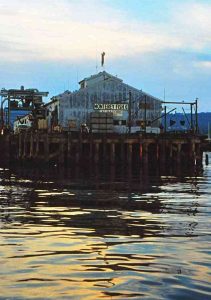
The end of the wharf from the water
There are some piers that seem to have a yin and yang disposition, if you know what I mean. The action can be hot or cold, good or bad, peaceful or hectic; moods that seem to depend upon some sort of unwritten script dictated (in romantic terms) by the gods, in realistic terms by the seasons or the whims of sometimes-unpredictable fish. Two stories, one good and one bad, show the schizoid nature of this pier.
The first story, the good or yang, occurred in July of 1984 while I was making one of my annual trips along the coast. I had stayed the night in Morro Bay, gotten up early and fished for an hour and a half at the Cayucos Pier. The pier was crowded and everyone seemed to be catching fish. Midway out, anglers were catching bucketfuls of small bocaccio, but I had seen far too many of the small fish the night before at the Morro Bay North T-Pier. Instead, I joined a throng of anglers out near the end of the pier casting artificial lures for Pacific mackerel and jack mackerel. The result was 15 fish for my fairly short visit. Next, I stopped at the San Simeon Pier, again for an hour and a half. Mackerel were absent but small bocaccio and lingcod covered the bottom. The result was 21 fish.
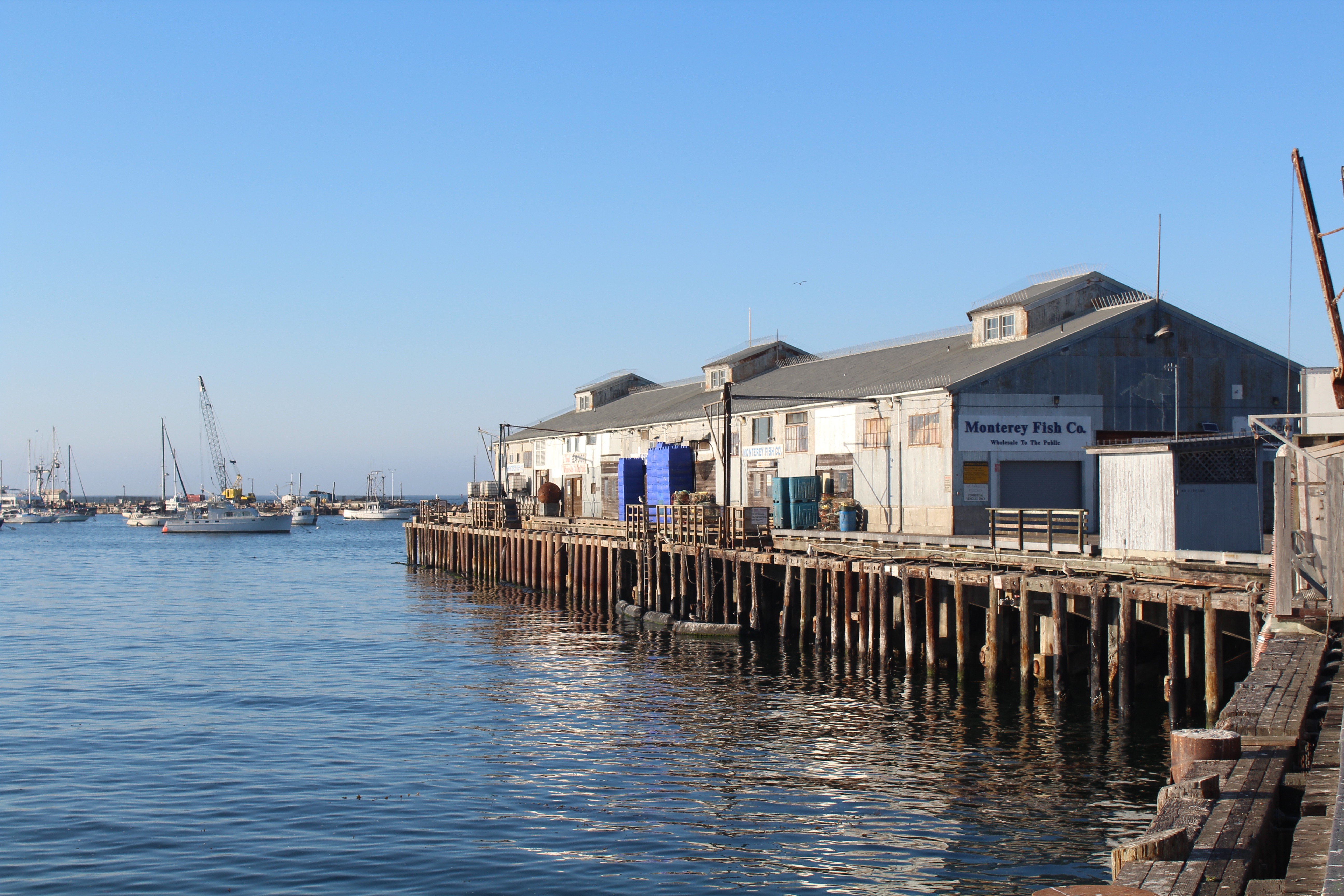
The left side of the end is a “no fishing” area
However, I was running late and headed north. In just under three hours I had traveled the beautiful Big Sur coastline and was fishing at the Monterey Wharf #2. But I wasn’t alone! The wharf was lined with anglers catching Pacific mackerel while reporters and television cameras tried to capture the torrid action. The sea itself was calm but as I watched the water a dark ball would form: a school of anchovies several feet thick and solid with fish. But a second school of fish, predators by nature, was also present and the mackerel in that school were larger and faster than the anchovies. Soon the mackerel would attack and the anchovy school would disintegrate as individual anchovies literally fled for their life. It was a Roman holiday, nature at its most vivid, and showed true the old adage survival of the fittest. The anchovies seemed to be using the pier and its pilings for protection but the pier proved to be a Maginot line of defense as the mackerel shredded the school of anchovies time after time. The mackerel were after the quick little baitfish and the anglers were after the mackerel. Mixed in with the “Mac Attack” were a few jack mackerel and, if an angler dropped bait to the bottom, small bocaccio and lizardfish. Again it seemed almost too easy as an hour and a half of fishing produced 32 fish. The highlight of an already excellent day was the torrid action and excitement at this Monterey wharf.
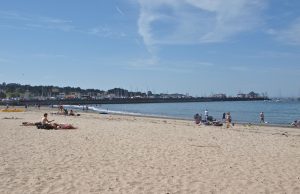
The view from the beach
An April visit a few years later proved entirely different, it was the yin or bad counterweight to my earlier visit. I had stayed the night in Monterey and gotten up early for a somewhat apprehensive “hour of the pearl” visit to the wharf. Why apprehensive? (1) Because of the bone chilling, 40 mile-per-hour winds that had accompanied a walk out on Fisherman’s Wharf the prior night. (2) Because of reports that said fishing was slow. Undeterred, my 6:10 A.M. arrival at Wharf #2 saw a beautiful morning sky emerge replete with a warming sun and the absence of any wind. Absolutely beautiful conditions! I was the only fisherman on the wharf, I had my pick of fishing spots, and I was soon at a spot that had proven to be successful on previous trips. I was even next to a silver fire hydrant that said “Jones 1981” on the side. Was it a harbinger of good things to come or did it portend gloom? Was I destined to have one of those unbelievable days that happen just once in a blue moon or was I in for the BIG disappointment? I wasn’t sure but I was prepared: several different kinds of bait, light and medium action rods, and a warm thermos of coffee.
As the Frankie Boy II arrived at the wharf, made fast the rope between boat and bollard, and began to unload its catch of squid, I made my first cast and began to wait. I waited and waited and then waited some more. I moved to different spots, I tried different depths, and I tried different baits and riggings. In two hours of fishing I had nary a nibble and was able to see why I was the only fisherman on the wharf—not counting the commercial guys still busy unloading their squid. To make it worse, the wind did come up, the kind of wind that required two shirts, a sweater AND a heavy jacket. Turned out that fishing had been lousy (terrible/appalling/horrible—pick your adjective) for several weeks and it didn’t intend to improve just because this famous pier fisherman was present. I was fishless in Monterey. Such is the nature of this pier.
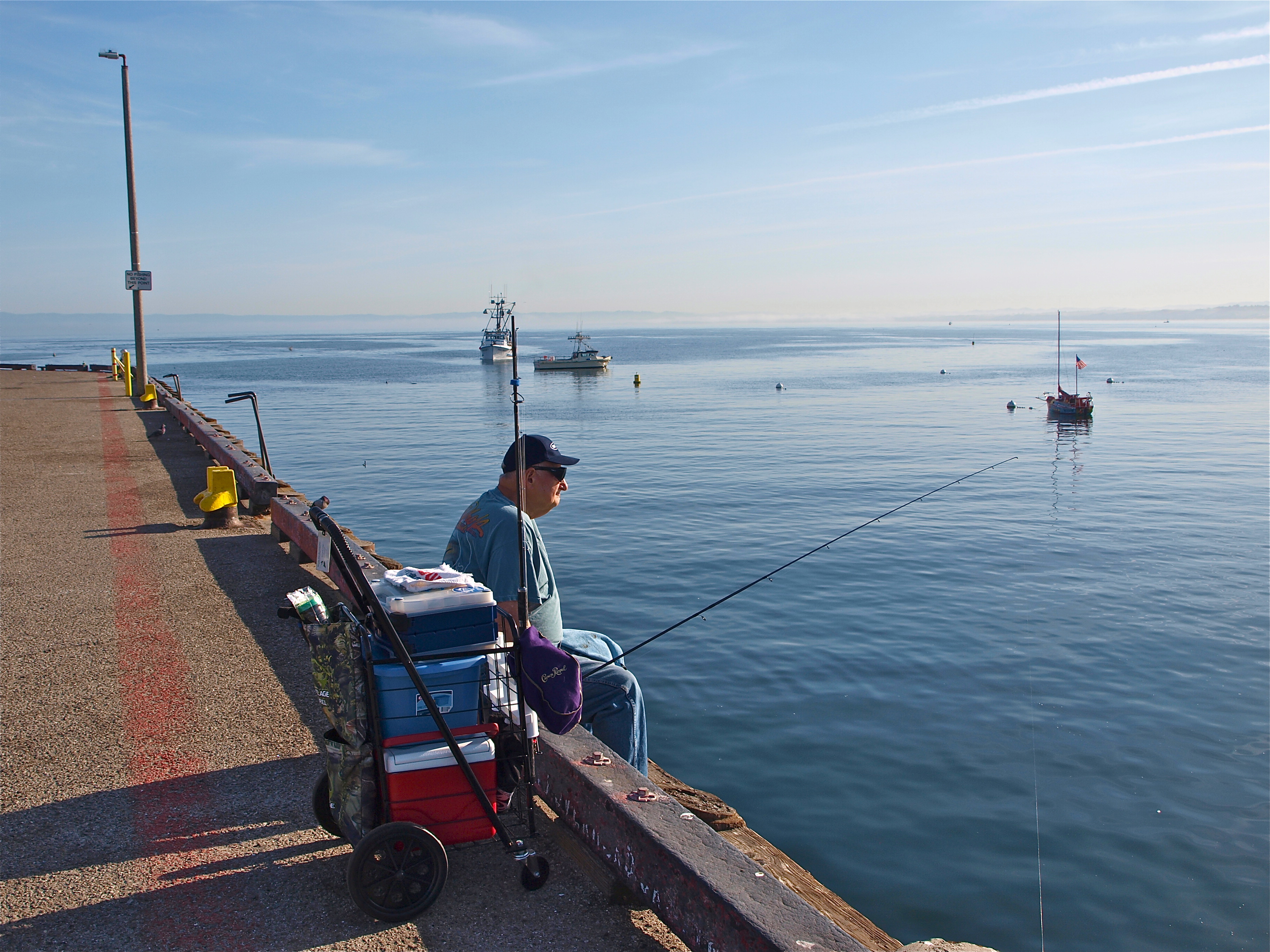
When fishing at the pier is slow, you can almost have the pier to yourself — my fishing buddy Mike Granat
Environment and Fish. Most visitors to Monterey seems to wind up down at the wharf during their visit. Many do not realize there are two wharves. The more famous is Fisherman’s Wharf, built in 1870 on the site of California’s first wharf and today home to restaurants, tourist shops, and a couple of Sportfishing landings. Adjacent, to the east, is a newer wharf that was constructed in 1926 (and repaired in 1983). Here, the commercial fishermen unload their catch and sport anglers try to make a catch. Fisherman’s Wharf deserves its praise; it is a fun place to visit, and it has a certain charm when the sea lions are barking and the sea otters are drifting on top of the bay. Still, for the pier fisherman Wharf #2 is the place to go.
Wharf #2 is fairly long at 1,636 feet, and fairly wide at 86 feet, but several sections do not allow fishing. The inshore section on the south side of the wharf (to about half way out) faces the boat harbor and is marked no fishing. The far end of the wharf is primarily a working area for commercial boats and also marked no fishing. The area on the south side just past the first building (near where the pier widens) was an area that I used to like to fish for perch but it appears now to also be a no fishing zone. Bottom line: the wharf is open to anglers on perhaps 75% of the north side of the pier.
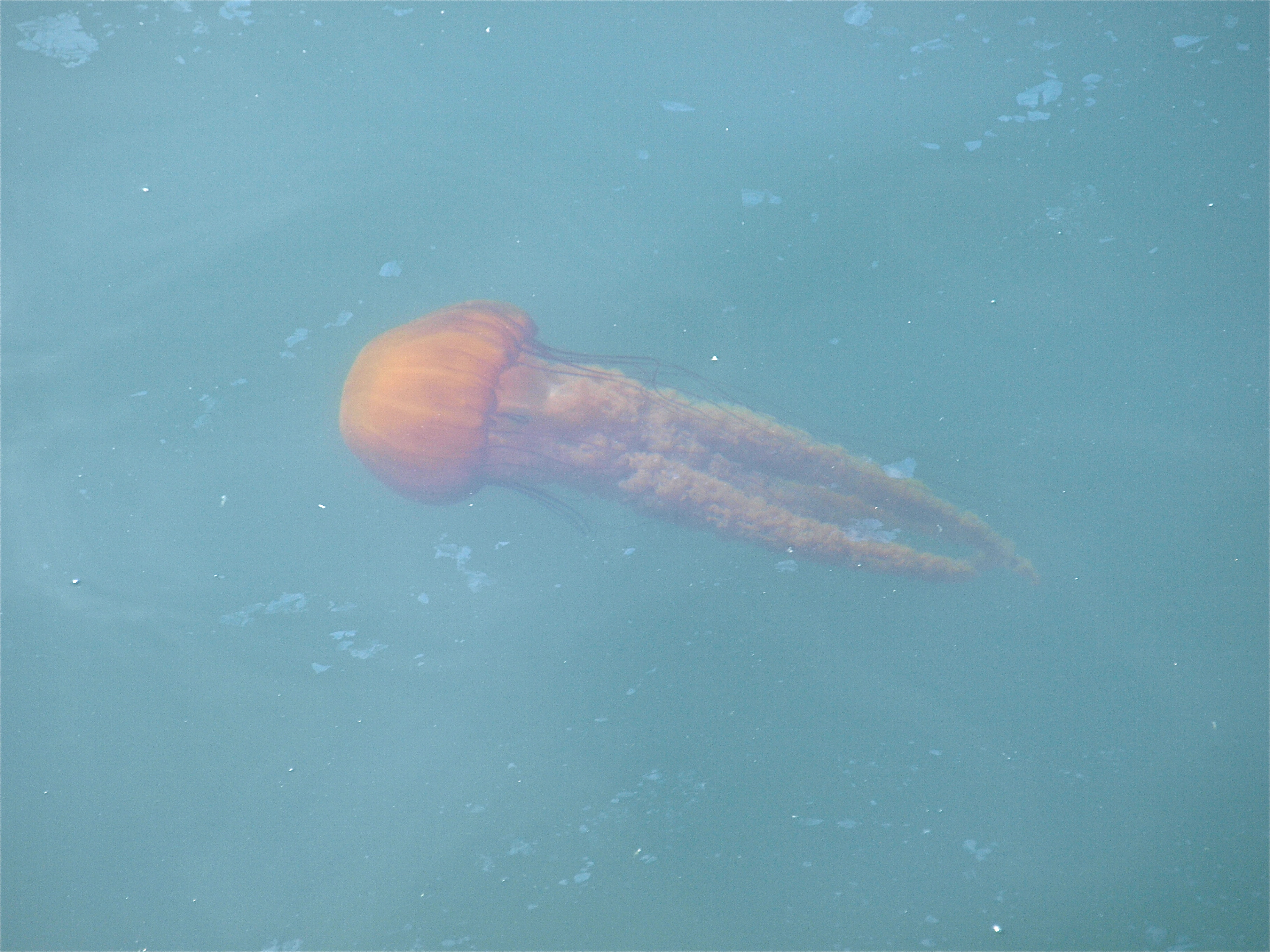
You may see some jellyfish come swimming along
The result is that the north side of the pier is heavily fished all the way from the shallow water surf area (which is generally mild) to about three quarters distance out on the wharf where water is fairly deep. At the foot of the wharf is a sandy beach area, the beginning of Monterey State Beach, a popular stretch of sand that extends from the wharf up past Seaside and beyond. (However, just to confuse things, the beach on which the wharf is located is called the Monterey Municipal Beach, just up the shore is the Window on the Bay Beach, and just up from that is the Del Monte Beach.)
Because the breakwater and the various structures in the harbor area block water currents from the south, the water north of the pier is usually very calm. For that reason it’s become a favorite place to take beginning divers and because of the divers we have a good picture of what the bottom looks like to the north of the pier.
Near shore, the bottom is sand, the water is shallow, and there are extensive beds of sand dollars (that attract fish like starry flounder and wolf eels). Sand-frequenting species such as surfperch tend to dominate the catch in this area. A short distance further out sees flatfish—sanddab, C-O turbot, starry flounder and numerous California halibut. Apparently the divers also record good numbers of thornback rays, bat rays and even some big electric rays.
The sand then gives way to small beds of eelgrass containing numerous juvenile fish while about 200 yards out from the beach begins a large shale reef known as the Tanker Reef or Shale Beds. Bull and giant kelp attach to the shale while crevices hold octopus and fish.
So, use the information to fish the zones: in the shallowest water expect the larger surfperch (barred and calico), in slightly deeper water target flatfish, batoids (rays) and a few selachians (sharks). Of course the wharf is long, so anglers can reach water depths that range from moderate to fairly deep and the deeper water is generally the area to try for pelagic species. When schools of sardines, jacksmelt, or mackerel (Pacific and Spanish) make a visit, expect the pier to be lined with anglers casting out bait rigs. Most people will catch fish but do be careful of tangles and use simple courtesy since space will be at a premium.
When the mackerel are absent many of the lines in the mid-pier area will be directed down around the pilings. The pilings are often blanketed by all manner of sea creatures but most important, for the anglers, they are sometimes heavily covered by mussels. In addition, especially during the summer and fall, there can be large buildups of kelp around the pilings. Food and shelter means small fish which can in turn mean larger fish. Typically schools of perch, a few rockfish (mostly juveniles), cabezon, small lingcod, and, during some years, pesky senorita hang under and around the pilings. Of course, like most piers along this section of the California coast, there can be tremendous variation from year to year (again, the yin and the yang).
Some years, especially warm-water years may also see some unexpected visitors. As example, a large school of striped mullet made a showing at the wharf during the summer of 2016, a far distance from their normal SoCal home. That same year saw a 6-foot-long sturgeon hooked off the wharf in September. As might be expected, the angler was not prepared for such a large fish and it eventually broke off after giving glimpse of its size to the excited anglers watching the fight.
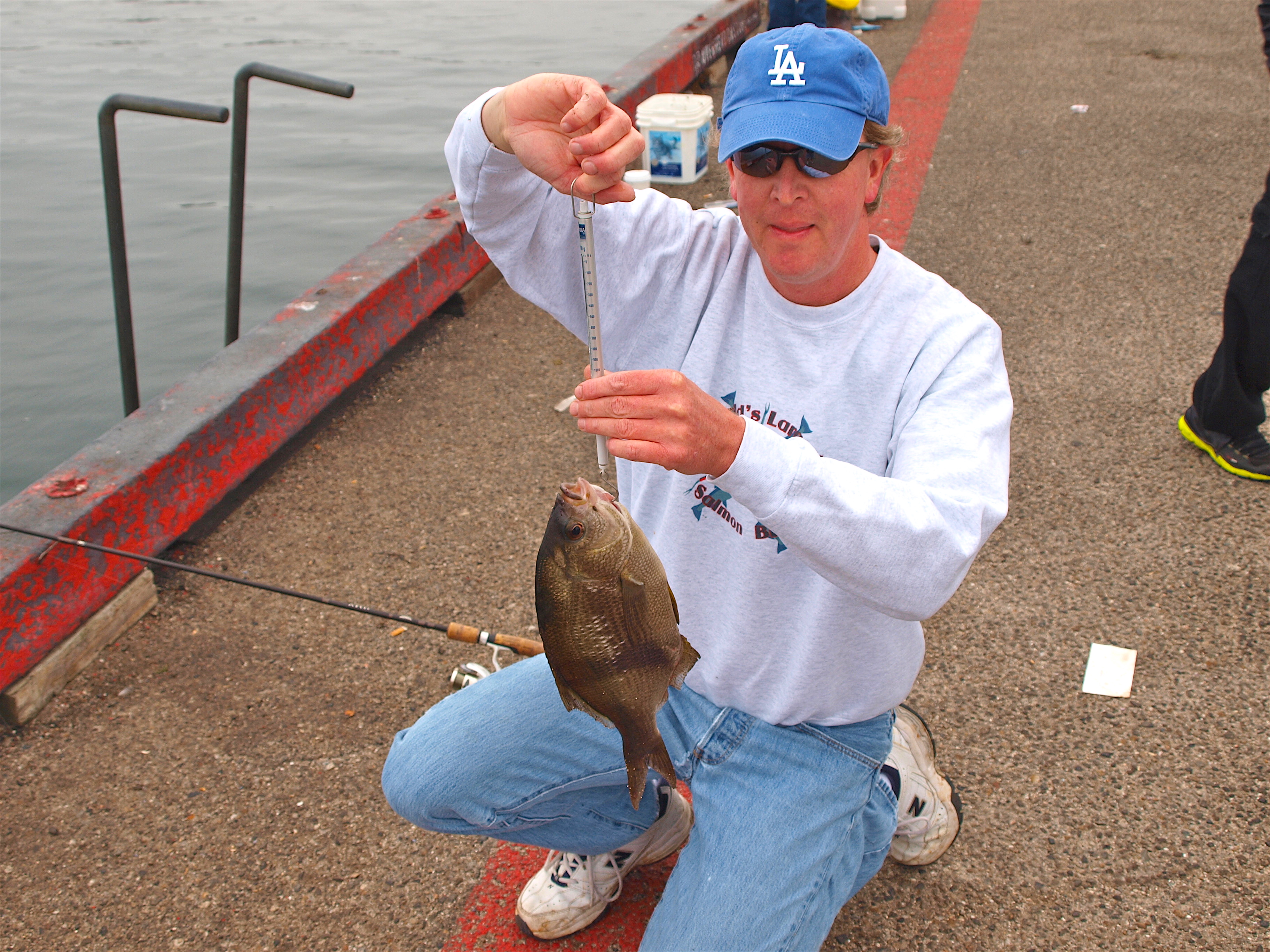
A nice-sized Pileperch caught by Madsteelhead in 2014
Wharf #2 —What is the best dive in Monterey Bay? … Lynn May, former owner of the Silver Prince dive boat, could dive anywhere he wanted. He claimed that the best dive in Monterey Bay was underneath Wharf #2. Beneath the wharf is a three-dimensional structure that has something interesting to see, from the water line all the way down to the 30-foot bottom. From the bottom, the pilings appear as Grecian columns reaching skyward.
The pilings of the wharf provide a substrate for an army of invertebrate life to cling to and flourish, and each has its own personality. Some are covered from the water line to the bottom with a lush carpet of corynactis anemones. Individual colonies may be fluorescent red, bright orange, lavender, or even shades of pink. Members of a colony show the same color, and colonies of different colors cover some pilings in a mosaic pattern resembling a patchwork quilt.
Other pilings are covered with a lush carpet of snow-white metridium anemones. Still, other columns are covered on their upper portions with the green, aggregating anemones, and in the lower portions with red corynactis anemones. Just to add a little diversity, an occasional piling is relatively barren of growth except for a giant metridium anemone.
Among the anemones hide an assortment of invertebrates and fish. Large sheep crabs hang upside down waiting to pounce on some unsuspecting prey. Among the carpet of metridium is always found a small, red octopus or two, and there are numerous shrimp and hermit crabs scurrying among the pilings. Photographers should look for colorful nudibranchs, both up on the pilings and on the mud bottom.
The calm waters provide a nursery for many of the larger fish. I have never seen so many lingcod in one place, none over about 14 inches long and many under 10 inches. Noting that these are much smaller than the allowed minimum size, this is not a hunter’s paradise. It is, however, a pretty good spot for fish portraits. Other fish such as cabezon, various species of flatfish, kelpfish, and rays may be found here in miniature versions. This is a great spot for fish photography.
Wharf #2 is also where Monterey’s commercial fishing fleet discards its incidental catch (e.g., what they can’t sell). Fish packing houses on the wharf continue to dump their waste into the water, and in season you’ll find dead blue sharks, bat rays, and sea lions. This activity is legal and the fish carcasses feed a large population of sea stars.
People always seem to drop things in the water and this place is no exception. The bottom is littered with fishing supplies, wallets, purses, pocket knives, and old bottles. If you can drop it, you will find one here. Regardless, if you search for valuables, memorabilia from the past, or that award winning photo, everyone will find something under the wharf.
— Bruce Watkins, California Diving, October 12, 2000
Fishing Tips. The pelagic schooling species— Pacific sardine, Pacific mackerel (blue mackerel), jack mackerel (Spanish mackerel), and northern anchovy—are the most numerous fish taken from the wharf. Schools of each, in fact vast shoals at times, may move in and surround the wharf for a few days, weeks or even months throughout the year. Sometimes it’s one species, sometimes it’s a mixed group with the different schools maintaining their assemblage at different water depths, and it can be an amazing sight with the synchronized twisting and turning of the entire school when they’re under attack by one of the local sea wolves (sea lions). The sheer number of fish can be amazing.
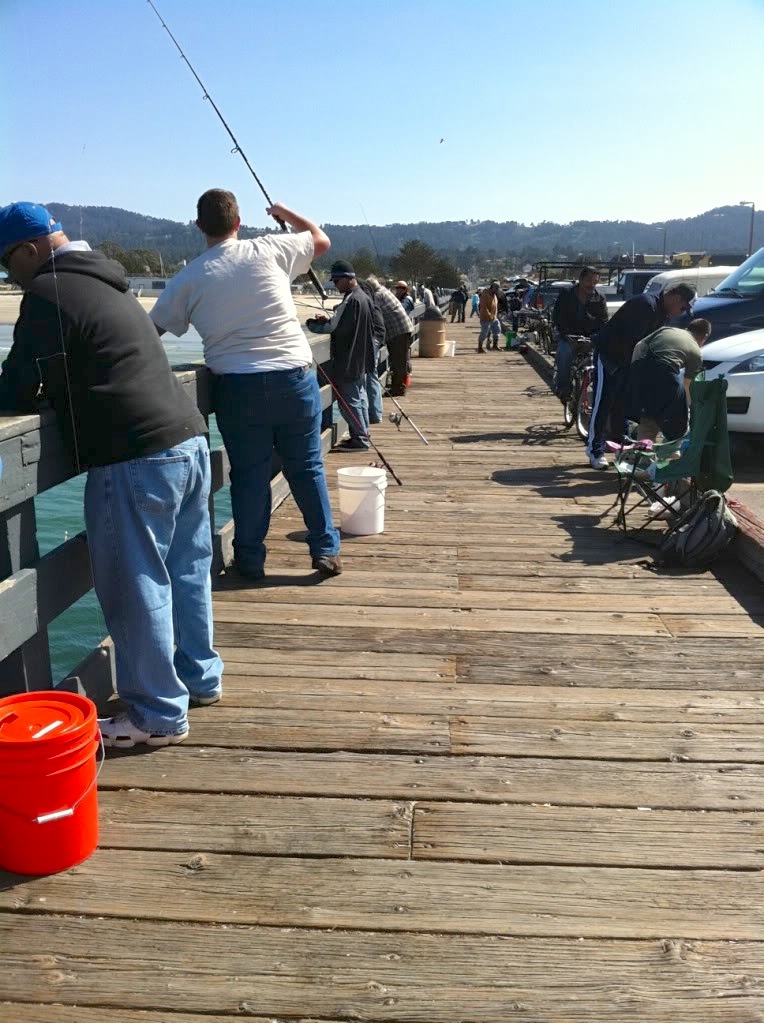
When the waters are filled with fish the railings will be filled with anglers and they’ll normally tote away buckets filled with fish. A person can literally catch several fish every cast until the arms wear out, and fifty to sixty fish an hour is easy. But even though none of these species has a take limit, don’t overdo it. If you’re looking to stock up on some bait or food it’s the time to go but make sure you’re going to use the fish you keep. Summertime into the fall months seems the best time to see these conditions.
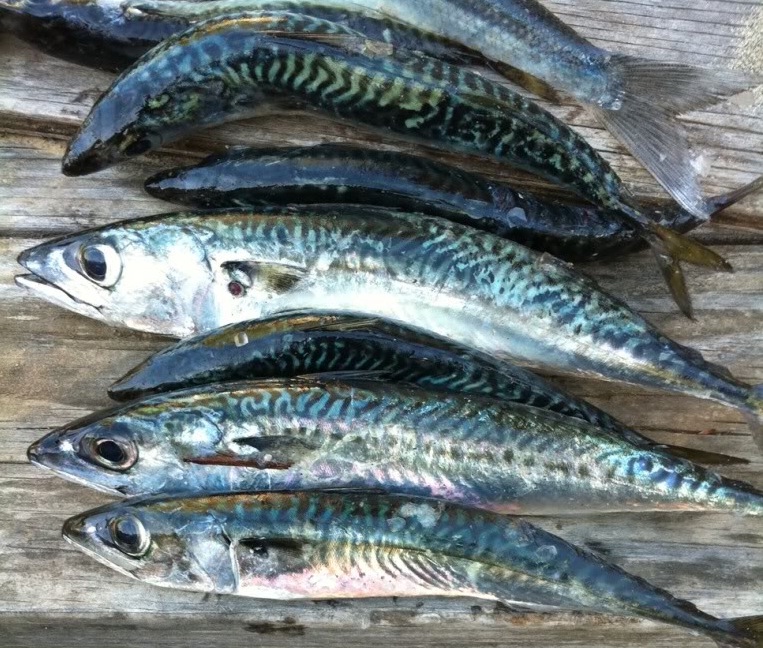
Pacific Mackerel taken in 2011
However, when the schools of pelagics are gone, anglers must depend upon the resident species and the fishing can slow. Surfperch will normally be the second highest number of fish taken. The numbers will be smaller but you can often find some type of perch much of the year. As a general rule, try winter to spring for the large barred and calico surfperch. Use pile worms, sand crabs, fresh mussels, or plastic grubs and fish in the shallow water near the beach end of the pier. Winter to spring may also see a starry flounder but for these flatfish fish on the bottom using cut anchovy or pile worms and fish slightly further out on the pier in a little deeper water.
Late spring to early fall will generally see a few California halibut being caught in the same mid-shallow area (and halibut to 44 pounds have been caught at the wharf). For these, the best bet is almost always live bait such as an anchovy, small shinerperch, or smelt—if you can get them. I have also heard a few reports of the larger flatties hitting on Scrounger-type lures and even on Hair Raisers, so don’t be afraid to give artificial lures a try. The same area can also offer up some tasty sand sole but for these, use a high/low rigging baited with pile worms, shrimp or cut anchovy or a Carolina-type rigging with the same baits. (And though divers report C-O turbot, most of the mid-size flatfish I have seen have been sand sole). By the way, the beach at the foot of the pier sometimes sees grunion visiting the shoreline during the summer. When the grunion run the halibut (and bat rays) often are right behind in the shallows. Target the flatties during such times.
Mid-pier to the end is the best area for the smaller surfperch and the pelagics. For walleye and silver surfperch, a small piece of anchovy or sea worm seems to work best when fished mid-depth using a size 6 hook. Jacksmelt, although often taken simply with bait rigs, sometimes prefer a baited hook and a leader made up of four to six size 8 hooks. Attach the hooks nine inches apart, bait each with a small piece of pile worm or shrimp, and fish the rig under a heavy bobber or float. The result is often several fish at a time.
As mentioned, many years see huge schools of Pacific mackerel, jack mackerel, Pacific sardine, or all three. Best bet for all of these is a multi-hook Sabiki/Lucky Lura-type leader with size 8, 6 or 4 hooks (size depending upon the species). Simply cast out and retrieve the leader or slowly work the leader up and down in the water after you have reached a mid-depth area. All three species (along with jacksmelt) seem to hit best at dawn and dusk but some days will see non-stop action all day long. The same rigging can be used for anchovies but use smaller hooks. Pacific herring will also occasionally make visits to the pier and can be taken with the same multi-hook bait rigs; most herring runs are in the late winter or spring months.
Somewhat common, although rarely in the numbers seen at other piers in Monterey Bay, are kingfish (white croaker). Most of these are taken on cut anchovies or pile worms fished on a high/low rigging; the best area to fish is mid-pier with a cast away from the pier.
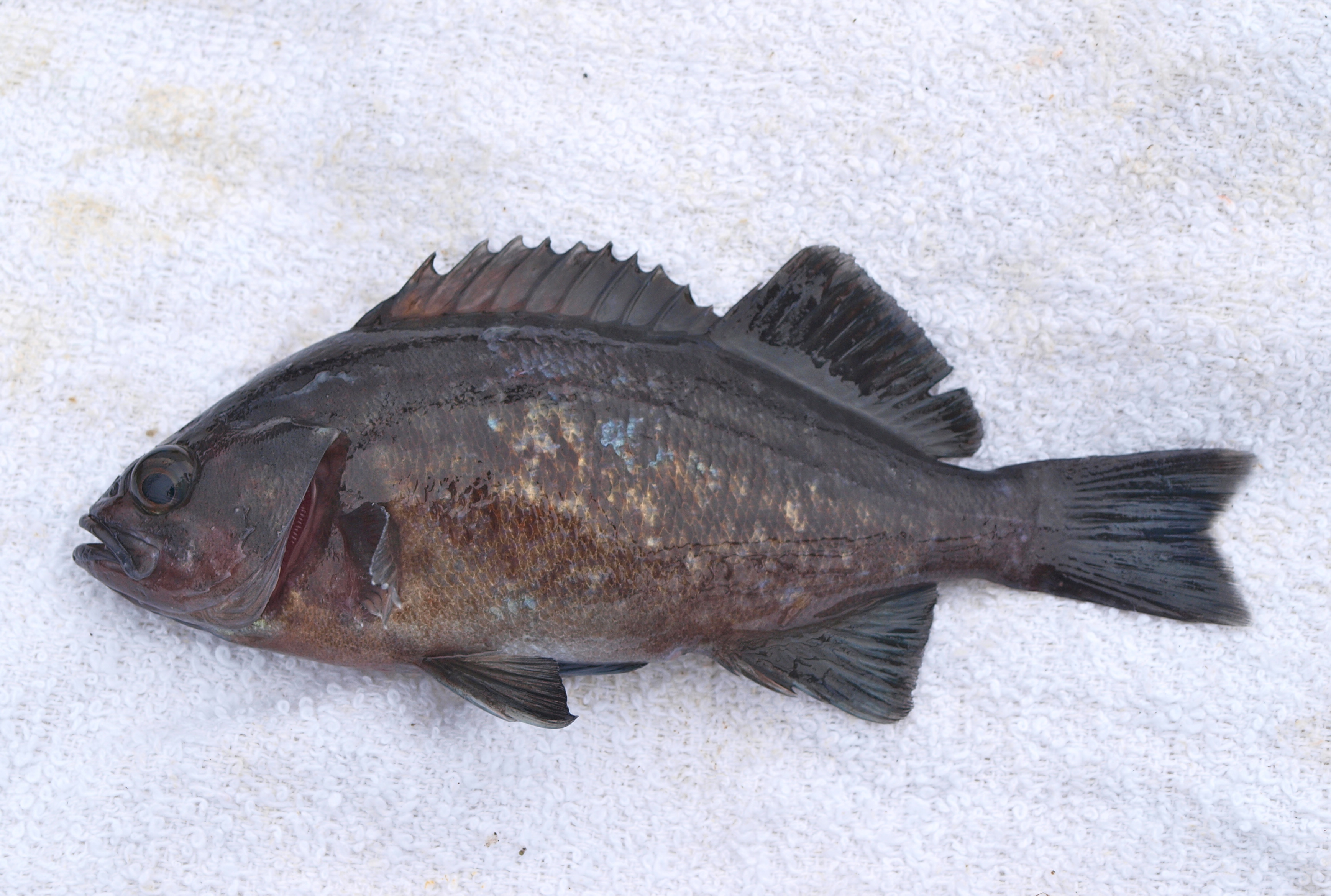
Blue rockfish
Summer and fall is the best time for small rockfish, and here the most common are small blue rockfish, brown rockfish, gopher rockfish and kelp rockfish. Fish for these under and around the pilings using pile worms and small hooks. At times, if the water is warm, you may also encounter some more southern species like blacksmith, garibaldi and kelp bass (calico bass), but they are not really common. However, another southern species, one that is often too common, is senorita. These pesky, cigar-shaped little wrasses will do their best to drive you crazy while stripping your hooks of bait (although you’ll catch an occasional careless fish). Unfortunately, when they’re present they are almost impossible to avoid.
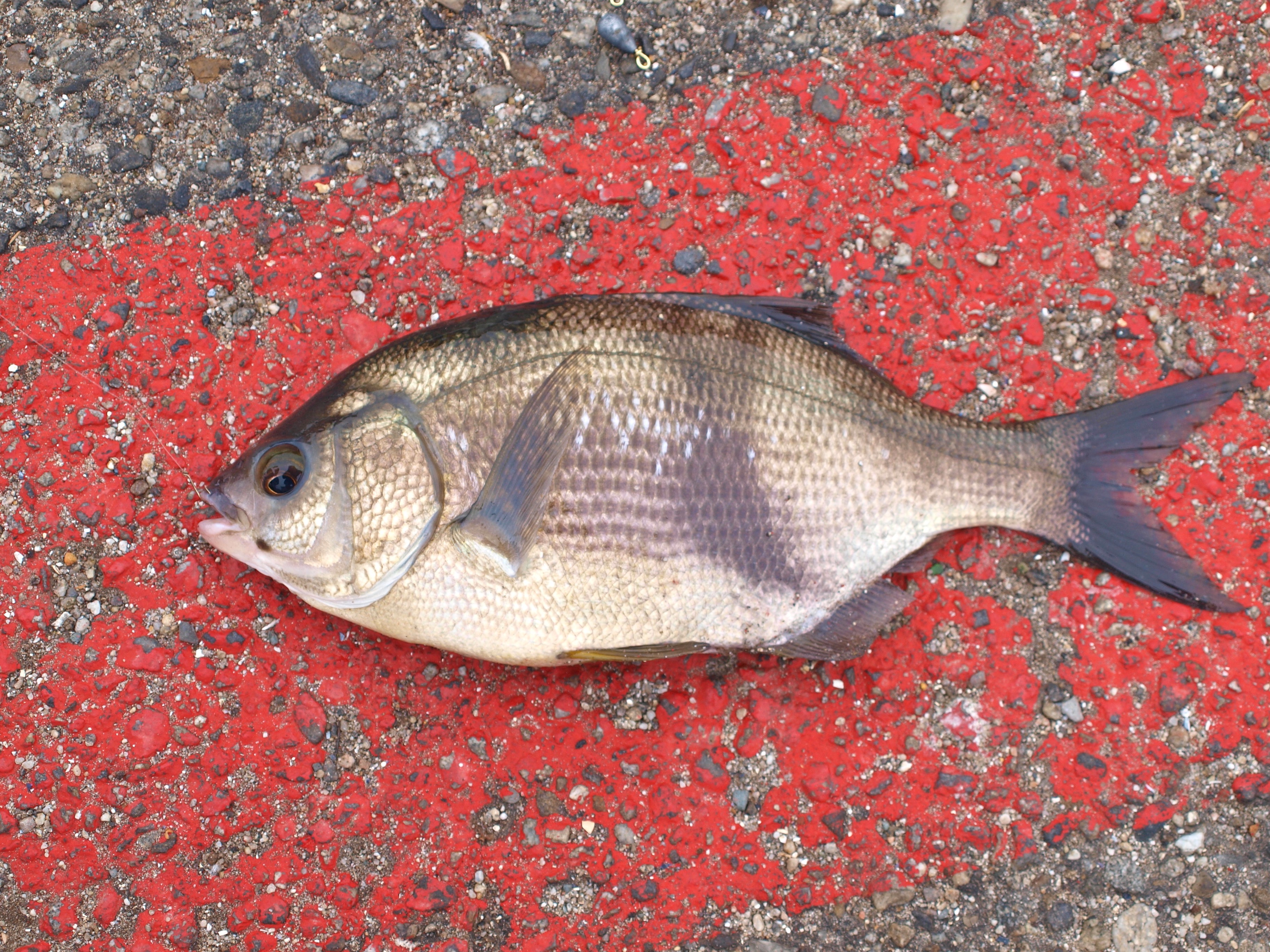
Pileperch
Fishing mid-depth around the pilings, using pile worms, fresh mussels or small (sidewinder) crabs is the best technique for the large pileperch and rubberlip seaperch. Each of these large perch is most prevalent during the winter to spring months but can show up throughout the year. Large rubberlips will also often fall for plastic grubs jigged up and down near the pilings; regulars say the root beer colored and oil colored grubs work best. Fishing on the bottom near the pilings with pile worms, fresh mussels, or small pieces of market shrimp will yield rainbow seaperch, blackperch and striped seaperch. Typically these are most common in the spring months although all may be encountered almost any month of the year.
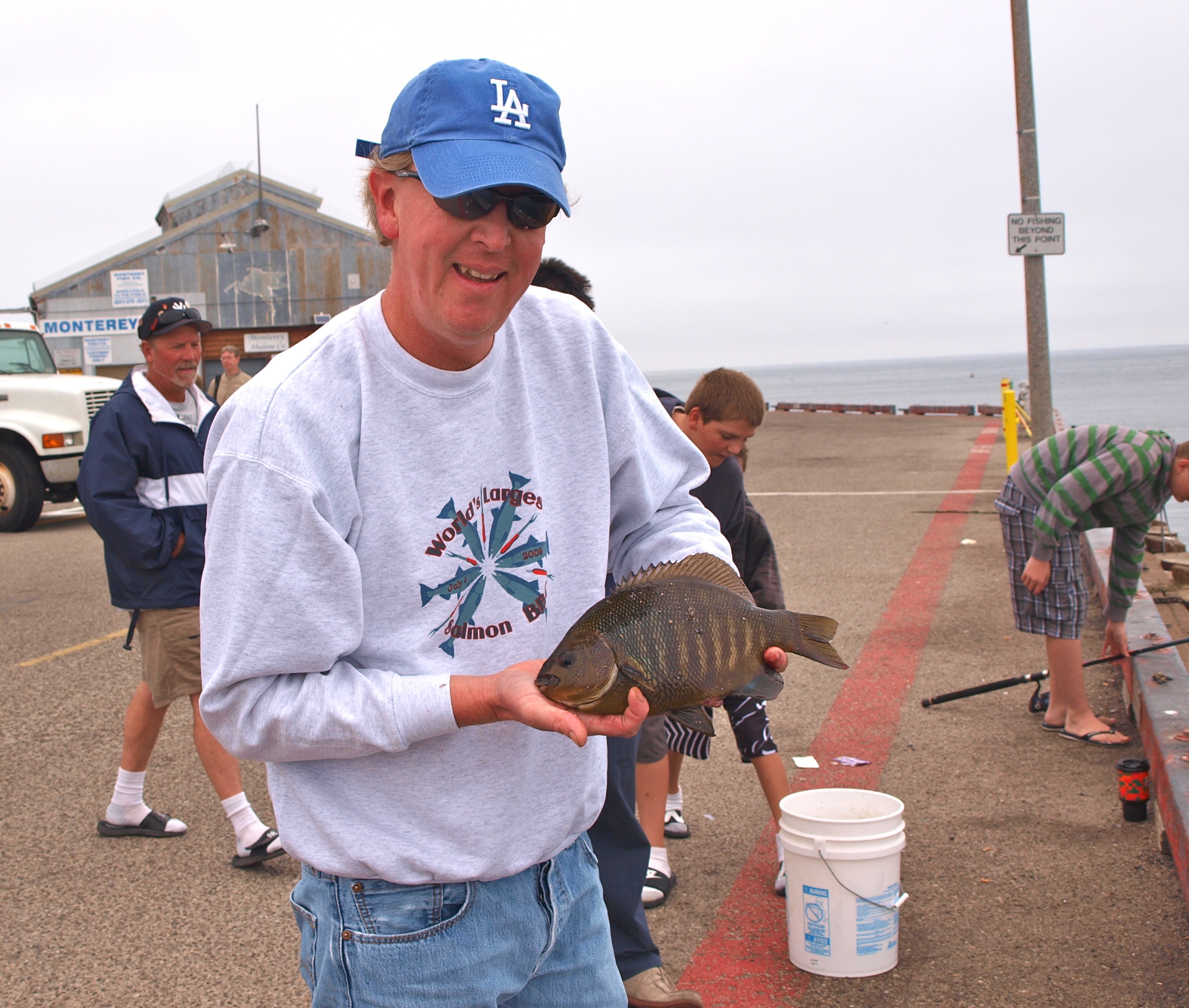
Blackperch caught by Madsteelhead in 2013
Another perch caught here is the sharpnose seaperch, a perch common only to Monterey Bay and a fish normally found in deeper water. These perch are present in some number almost every year, but occasionally the pier will see large runs of the fish, most often in June and July. Although numerous, they can be difficult to catch. Regulars tend to use rigging that consists of a size 6 or 8 hook at the end of the light line, a splitshot sinker about two to three feet up from the hook, and a tiny bobber that keeps the hook only a few feet beneath the surface of the water. The line is watched closely and, when the bobber is submerged, a quick jerk is made to hopefully hook the perch.
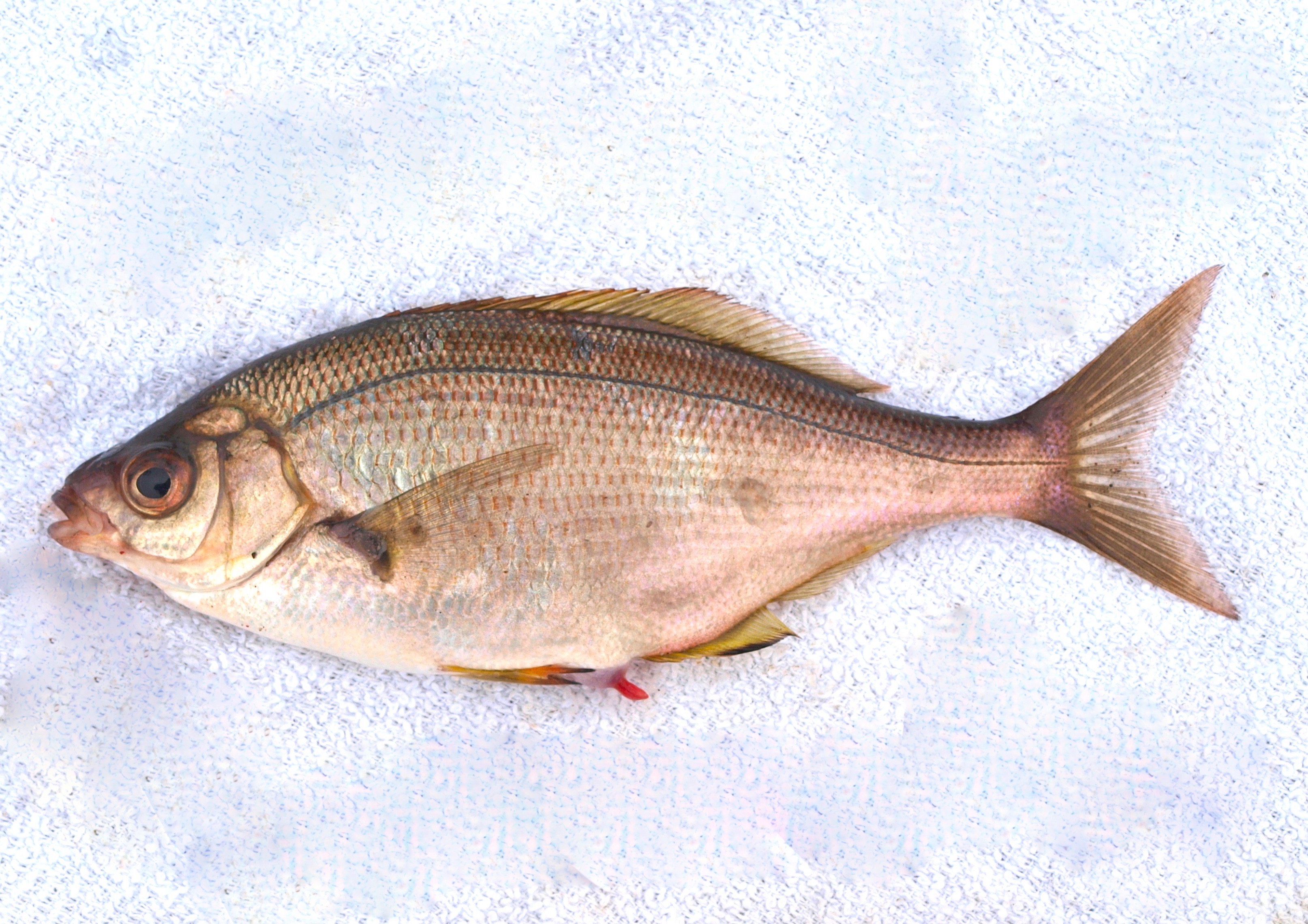
Sharpness Seaperch
A fish that is sometimes found in unbelievable numbers, especially during the summer, is that little ol’ dab—the speckled sanddab. If you mistakenly let a line rigged with small hooks (such as a multi-hook bait rig) rest on the bottom, a dab may show up on every hook. Unfortunately, these sanddab are big enough to grab your bait but really too small to eat. Most days would probably yield hundreds of these small fish if anglers fished for them but we’re talking tiny sanddabs here, each 3-6 inches long and useful only as an attractant for larger fish. I have tried them as bait but with little success to date. The good news is that sometimes the larger Pacific sanddab may also show up. If they do, you’ll often catch 2-3 at a time and you’ve got some good eatin’ available to you.
A trio of prized sport fish, also visit the pier. Most years will see some king salmon caught during the late summer to fall months (but primarily in the fall). The majority of the kings will fall to lures (especially 5/8 or 3/4 oz Krocodile lures with silver/blue prism colors) while a lesser number will be landed on whole frozen anchovies fished under a bobber. Regulars report that the salmon prefer the early evening hours.
Most years will also see a few striped bass taken from the wharf, again during the summer months. Most of the stripers are taken using lures (such as Hair Raisers) or while fishing on the bottom with live bait (small perch or smelt) or cut bait (sardines or anchovies).
Early winter (November) will often see casters trying for small steelhead along the inshore section of the wharf. Various jigs and spoons seem to be the preferred method for the 16-22 inch fish, but I would think worms might also work. There has been a problem with people snagging salmon and to a lesser degree the other fish and the city has tried to respond with some reasonable rules as seen in the following:
New Rules For Fishing Off Wharf II
For the last couple of falls when the salmon are present off of Wharf 2, there has been a frenzy of people casting overhead and standing on the railing trying to catch or snag one of these fish. Overhead casting and the jerking motion associated with trying to snag the fish, all while standing on the railing, presents dangers to anyone walking or driving behind these activities. There have been, in fact, several serious injuries directly related to this, and numerous broken car windows and dented car hoods from sinkers and hooks being cast backward. Therefore the City Council has made it illegal to stand on the railing while fishing off of Wharf 2., as well as making it illegal to overhead cast.
—The Newsletter of the City of Monterey Waterfront, October 2003
A less common fish, although one that grows to fairly good size, is wolf eels, and an occasional one will be landed by anglers fishing down around the pilings. My bias is showing here but I recommend letting them go. They’re neat little (and large) creatures.
A very unusual fish for the area, one that is rarely seen today, although occasionally seen in the late 1800s, is yellowtail; one was caught in 2012.
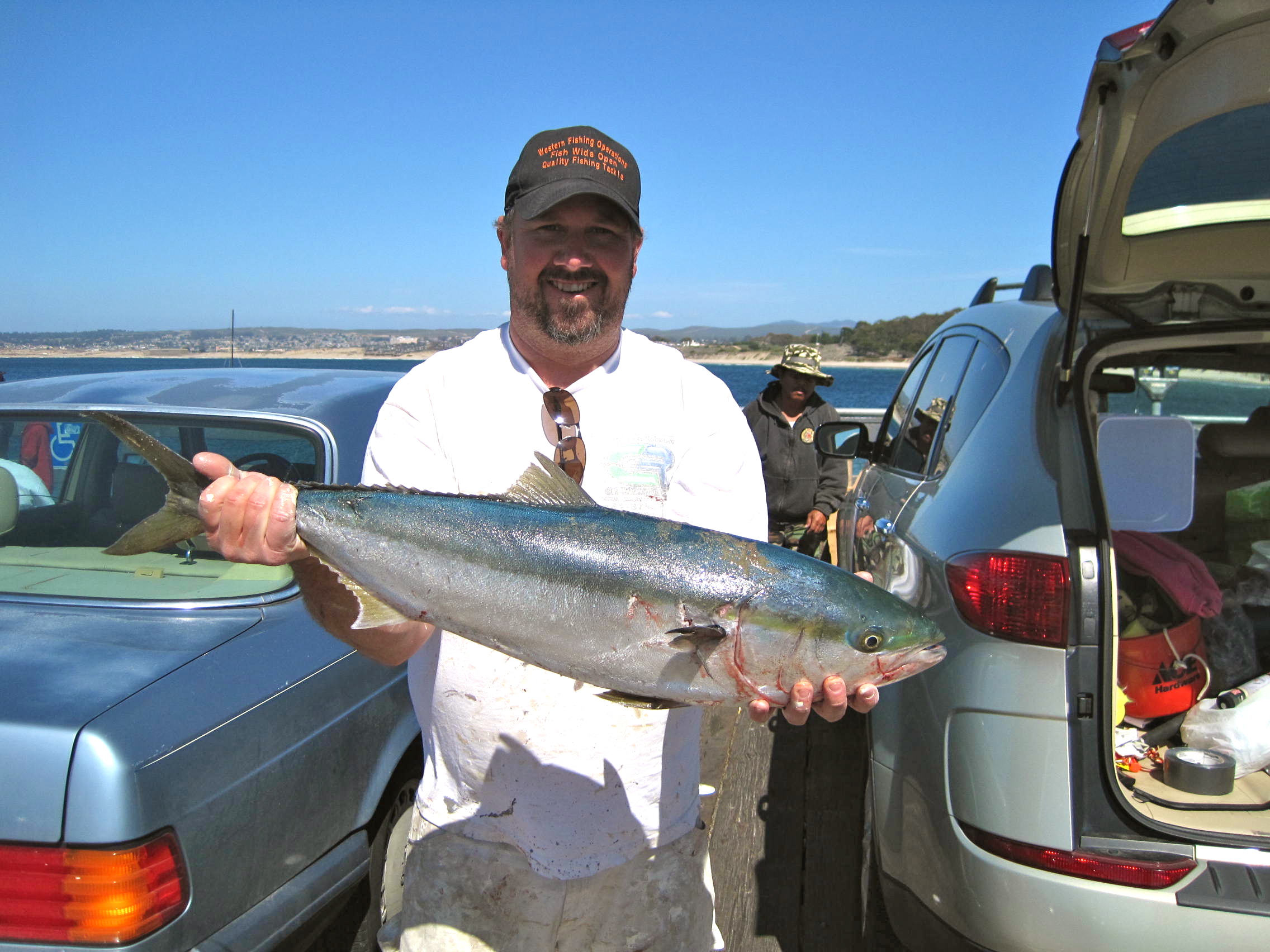
Yellowtail taken in 2012
Although the pier is not really noted as a good pier for sharays (sharks and rays), it can be, at times, fairly good for bat rays (especially in the fall). Most of these large rays are taken at night while using squid as bait. Be sure to bring a stout rope and a good-sized net if you’re after these powerful fighters. And, say a prayer—it isn’t easy keeping them away from the pilings, the kelp, and the flotsam and jetsam that sometimes litters the water. Lesser numbers of other sharks and rays are taken—leopard sharks, smoothhounds, and a few thornback rays. At least one angel shark was also reported from the wharf (1999).
Another visitor, although not as frequent now as in years past, is the common market squid (Loligo opalescens). When the squid schooled in the nearshore waters, anglers would flock to the pier at night and land buckets of the tasty little “calamari.” Generally this occurred mid-May to June, but the numbers seem to have decreased in recent years. However, TheEmptyBucket reported in May of ’06: “Squid were out again tonight at Wharf #2. Not as easy to catch as last night, though. Last night I was able to catch them on a Sabiki. Tonight I tried that for almost two hours while folks on either side of me were slaying them with squid jigs… One of the regulars took pity on me and loaned me a jig and then I started getting them almost immediately. A Sabiki with squid jig attached to the bottom was defiantly the way to go. I put about 40 3-5-inch squid in the freezer… Also had a blast.” Grammar police reported that same month: “FYI, Live squid being caught from the pier on Sabiki rigs. 5-8” range. RF candy for sure!” La mosca posted a note to the PFIC Board in July of ’08 that said: “about a month back, at sundown, I caught live squid, loads of them under and close to the wharf; could see them flashing their colors.” Sin_Coast reported in 2008, “We get ‘em [squid] off Monterey Wharf #2 consistently throughout the summer.” So the squid are still there, not just in the unbelievable numbers of past decades.
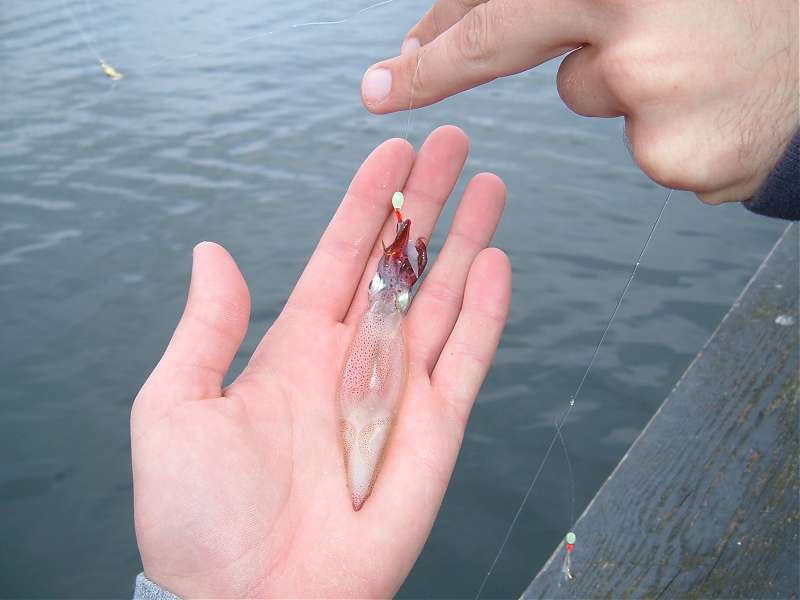
A small squid — picture provided by TheEmptyBucket
In addition, there’s the giant Humboldt squid that have become more prominent in California waters since the ‘90s. At least one giant squid was caught during March of 1998. The two-foot-long mollusk was caught on a lure by the startled angler. At the time, party boats were experiencing a good run of the 2-4-foot-long creatures out in deeper waters. Another non-fish, cephalopod species is octopus and just enough are caught to keep it interesting.
Lastly, you’ll see some people crabbing from the pier but I’ve never really noticed too many crabs being landed. Divers do report good numbers of sheep (spider) crabs hanging on the pilings but few seem to make it into the crab nets. Perhaps there are just too many sea otters and sea dogs in the vicinity for good crabbing.
Abalone Nursery — Kelp beds help rockfish population
There’s something fishy going on under Wharf 2. Art Seavey, co-owner of the Monterey Abalone Co., isn’t just growing expensive marine gastropods in the barrels and cages hanging from the pier scaffolding. He’s also helping researchers with their fish studies.
Young rockfish find shelter in and around the red abalone barrels, and oceanographer Jerry Norton of the National Oceanic and Atmospheric Association and marine biologist George Isaac of the Department of Fish and Game are monitoring their growth.
Rockfish, sometimes called Pacific red snapper, are a type of groundfish caught by bottom-trawling fishing boats; bocaccio is one of the familiar species. Rockfish have an uncommon trait for marine fish: They give birth to live young, rather than laying eggs. The larvae swim from deeper water to nutrient-rich nearshore areas like piers, where they feed on baby shrimp, crab eggs and other small fish.
“Down at the abalone farm they have those cages with kelp in them, and they make a very rich environment,” said Norton. “The fish take up residence around those cages.” Norton monitors the number of baby rockfish that make it from their birthplace in deeper water to the pier.
From 1970 to 1995, said Norton, the number of rockfish off the Central California coast had declined by 80 percent. “Some of them have become depleted because they haven’t found exactly the right conditions every year,” Norton said. But recent studies show rockfish might be making a comeback. “Beginning in about 1999, there’s been a turnaround in abundance, and we’ve seen much more at the abalone farm and around piers,” Norton said.
Norton thinks the recent increase in numbers of rockfish is due partly to the amount of nutrients along the Central California shore. Places like the Monterey Abalone Co. can play a part, providing the fish an endless buffet and a protected environment in which to grow. Workers at the Abalone Co. also help researchers track the number of fish that make it to shallow water each year… “Something that works out nicely is that when they pull up their cages to clean them and add food, they sometimes trap the little fish, and they save them for me,” said Norton. Isaac, of the Fish and Game Department, has also been studying rockfish collected from among the Monterey Abalone Co. barrels for the past three years. After he looked at several areas where he thought the baby fish might be abundant, he finally looked around the pier. “Sure enough, we found a lot of rockfish,” said Isaac.
Seavey has faced some criticism for his business, mainly from people who think kelp harvesting destroys sea otters’ homes. The Monterey Abalone Co. feeds its 200,000 abalone five tons of kelp from the Monterey Bay a week.
But kelp forests in the Monterey Bay are doing just fine, says one marine biologist. “If you cut the top of kelp, new fronds grow quickly to replace them,” said John O’Brien, who helps the Department of Fish and Game survey kelp forests on the California coast each year. Conditions in the Monterey Bay are highly favorable to kelp growth, he said. “You probably can’t harvest it fast enough to affect its growth.”
The abalone farm has served as a home to other marine creatures over the years. In addition to rockfish, Seavey has seen shrimp, octopuses and lobsters that are far out of their range in the abalone barrels. But Seavey sees so much abalone that he rarely even eats them anymore. “When I go home, the last thing I want to see is an abalone,” he said.
—Elisabeth Nadin, Monterey Hearald, February 8, 2003
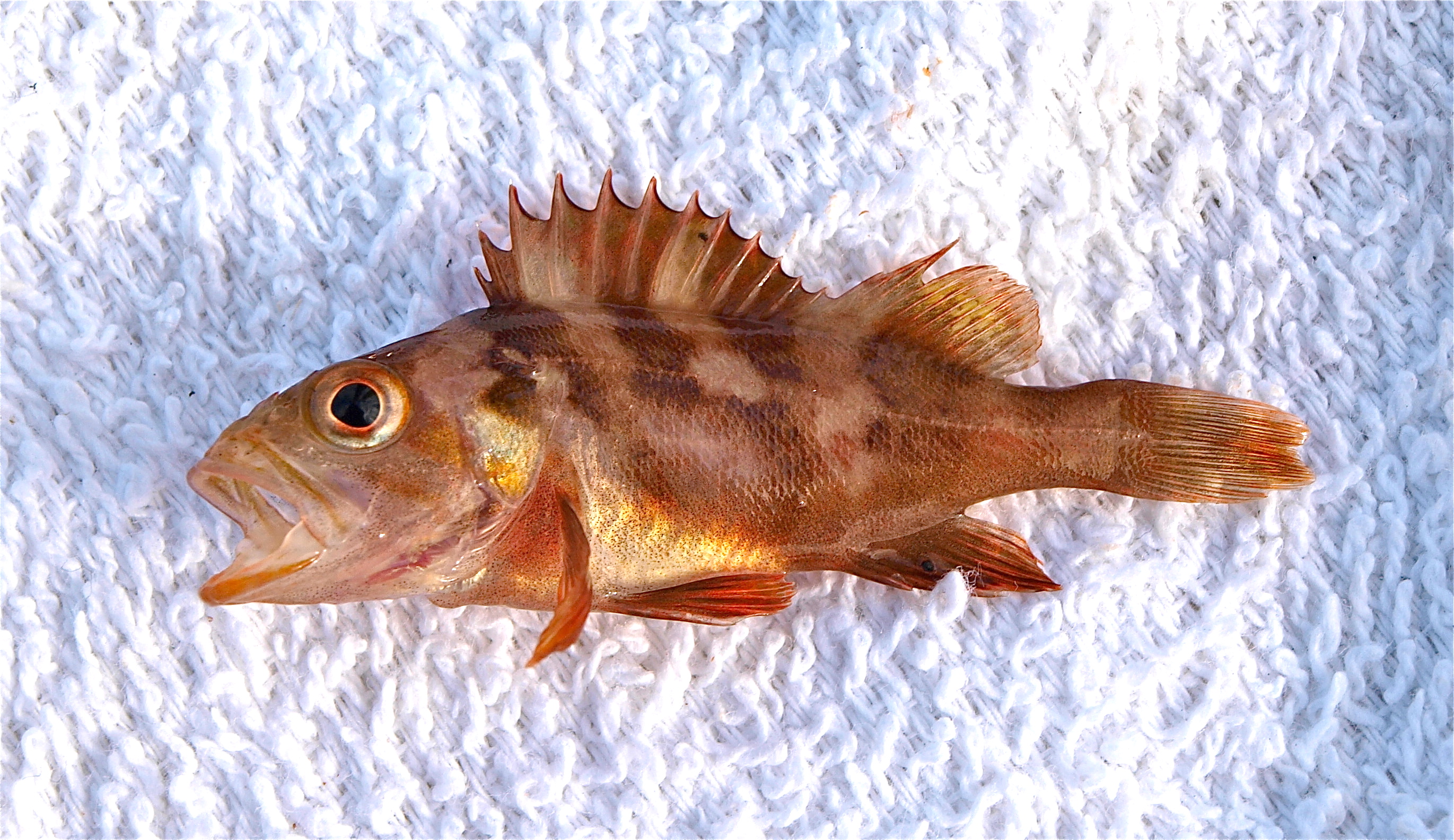
A juvenile copper rockfish taken in 2015
The Pier Rats Speak
Date: March 2, 1999; To: Pier Fishing In California Message Board; From: Calder Deyerle; Subject: Monterey Wharf #2
The things that we are catching at the wharf are a few steelhead and a few jacksmelt. I have also seen a couple of perch.
Date: April 16, 2001; To: PFIC Message Board; From: avidangler; Subject: Monterey Wharf #2
The perch have arrived. Today I saw the first large school of perch under the wharf near the fuel dock (midsection). There were lots of silvers and pileperch, so out came the rod and away I went! The tide was coming up (it was 3:00) and I tied on a 1/3-ounce jighead with a motor oil perch grub. I caught a large rainbow, three rubberlips (one was around 2 lbs), several pileperch, and a few silvers. I had never seen pileperch so aggressively hit artificial grubs like they did today. They swarmed it. My pal James was getting them on a bubble gum pink grub, although not as many. Motor oil was the ticket. Should be many, many perch in the next few months. Those rubberlips are tricky to land on four-pound line near the pilings!
Date: September 30, 2001; To: PFIC Message Board; From: steelhead; Subject: Monterey salmon “on fire”
Hello everyone, this message might be a little late… but I have to post it anyway. The salmon have arrived in large numbers off the Monterey pier. And I mean LARGE NUMBERS. Schools of 30-40 salmon cruising back and forth in front of the pier. Some of the regulars were catching 20-25 salmon a day in just 5 feet of water. Myself, I caught 6 in just two hours. The salmon came in right after the big thunderstorm we had last week. Since then it has been non-stop action. The bad part is that salmon season ends today… so get down there today if you can. Steelhead
Posted by jason chin
Treble hooks with a feather does not count. Jason “bayrunner”
Date: May 4, 2002; To: PFIC Message Board; From: avidangler; Subject: Monterey Wharf #2
James and I fished the pier at around nine this morning for perch. We fished under the pier around midway with pile worms on a 1/32-ounce leadhead and caught and released around 35 or so rainbow seaperch and pile perch on ultra light tackle. There are many silvers also but I only landed one of those, as they were being finicky. Not much else happening pier wise save for a few small smelt here and there. -avidangler
Date: July 25, 2002; To: PFIC Message Board; From: avidangler; Subject: Re: Leapin, what’s “lining?”
You all know I’m from Monterey and fish the Wharf #2 regularly. I was not present on this particular day in question because I have bills to pay, so I saw no such incident of snagging with a bare hook. In notsosmart’s post, the fish was foul hooked with a bare hook. That is snagging. You must use a lure to catch a game fish, or bait. Period.
Lining is a method in which one uses a long leader and a bead or yarn to hook salmon or other fish in the mouth. Whether it is voluntary or not depends on the fish. Salmon will hit yarn, and they will also hit a bead. The majority of fish hooked on the rivers I have fished while people were using this method were involuntarily hooked, many in the mouth, some in the head, others in the back or tail. The wardens I have talked to say that if the fish swims off with your line and it is mouth hooked it is legal. Period.
Now for avidangler’s stance on “lining” and “snagging” at Wharf #2. I will NOT snag fish period! The fine is like a thousand dollars, it is hectic fishing, and frankly I will legally hook many more fish than the average snagging moron. Salmon come to Wharf #2. Why? They are planted in the harbor as fingerlings and allowed to mature to smolt size. They return to the “river” of their origin, which is the harbor. These fish turn dark in saltwater and die. They do not reproduce. We have asked the DFG to extend the season so that less of these fish will be wasted, due to the fact that the return usually peaks after ocean salmon season is closed. Our requests have fallen upon deaf ears.
The DFG is fully aware of last year’s snagging problems and many anglers were issued citations as a result. This year we shall see what happens with the snaggers. So far I have seen anglers throwing spoons and lining fish so as far as notsosmart’s report of snagging I cannot confirm this.
The DFG is allowing lining of these salmon. You know what I say? Why not? These fish are going to either get eaten by harborbags and sea lions (go there at night and watch the gauntlet!) or die and get picked at by seagulls and crabs. The sole purpose of these fish is to boost sport catch. I would like to see them not go to waste myself. If that means people line rub them, by all means why not. After the sea lions get them all fidgety they will not readily strike bait or artificials, although I know a few tricks (heh heh). Better that people get some sport and some dinner. If the law allows it, that’s the bottom line. The practice will continue. There will be some bad apples in every crowd. Avoid them.
Date: September 14, 2002; To: PFIC Message Board; From: avidangler; Subject: Monterey Wharf
The salmon action has been good. My pal Frank hooked a beauty off the beach adjacent to the pier on a #6 Blue Fox spinner this morning. I just finished eating some of that fish a little while ago. Last week the same Frank got a twenty-four ponder on same said spinner, and yesterday my pal Orby nailed a 34 pound, 1 oz fish on pink yarn. No joke. He did well to land that pig!!
Date: October 26, 2006; To: PFIC Message Board; From: pinoy; Subject: Plenty of bat rays in Monterey!
They have been catching bat rays at the wharf for a few nights now. Finally, I had a chance to try it last night. I was using an Eagle Claw “Surf Beast” 10ft rod, Okuma AV80, 80-lb spiderline (25-lb diameter), steel leaders topped with 2/0 hooks, and squid bait. I started fishing at 7pm and first 20 minutes was slow for me although everyone else seems to be catching bat rays left and right. Boredom was followed by some teasing from my pregnant wife. She said that if she’s not pregnant and have strength to fight the rays, she would have been catching after a few minutes of casting out. She said I have until this time next year to hold the family record on bat ray catch even if I catch the tiniest one in the bay. She already beat me in the MF eel department. Hehehe!
Anyway, at around 7:30 I felt a tiny tug so I set the hook. Yup! I felt a strong pull trying to peel off out to open water. After reeling a few yards back the ray came straight back and to the side, aiming to go under the wharf. Oh man, I thought I was gonna lose it. I was able to recover line fast enough to keep pressure on the ray and to coax it to follow me towards the end of the railing. With a friend’s help lifting the line hand over hand I finally landed it. It was around 30-33” wingspan. I don’t know the weight. My friend took it home for soup and I kept the tail. I caught four more (3 released) afterwards ranging from 20-35” with two of them falling into the water just a few feet from the top of the wharf when we tried to lift them up. I based the size of the two that dropped on the comparison of how they were spread between the post of the wharf while we were pulling them up. I also caught a 2′ long skate that did not fight at all.
My co-worker and PFIC member MBRat finally showed up at 9pm. We stayed with him until 11pm. He caught total of 5 bat rays, but was only able to land 1 which was about 30-34” wingspan. The others were lost while trying to lift them up onto the wharf. All in all it was a fun night. Mrs. Pinoy was happily watching and encouraging me. She already said I will be the one watching baby next year while she catches bat rays. Hahaha!
Date: October 27, 2006; To: PFIC Message Board; From: Ken Jones; Subject: Monterey Wharf #2 — macs/jacks in force
Shot down to Monterey this morning at 4 AM to check out the mac action and the mackerel are definitely there. But what’s really there is a huge mixed school of Pacific mackerel and jack mackerel (called Spanish mackerel by many people) and they are on both the inside side of the wharf and the outside side.
The jack mackerel are small size to medium size and seem to be hanging above the Pacific mackerel. If you want the jacks use a small size hook Sabiki with a one-ounce torpedo and keep it closer to the top.
The Pacific mackerel are almost all medium sized fish and, as said, seem to hang under the jacks. Use a two-ounce sinker for them and let it sink deeper in the water.
For both, a slow steady retrieve seems all that is needed. Main problem is that you will get 2-5 at a time so I recommend medium tackle if you’re going to use a Sabiki for them. If you use a light outfit, and the larger mackerel hit, you’re likely to have a tangled mess. But it’s only money.
Instead of the Sabiki put a couple of size 6 hooks on your line with a one-ounce torpedo sinker and small pieces of mackerel. You’ll have a blast catching the macs. Size 6-8 hook for the jacks. You will not get as many fish as the Sabiki’s but I think it’s more fun.
Finally, the fish are really thick and it would not be hard to catch 75-100 fish an hour if you know what you’re doing. Better is to plan out what you want. I wanted a certain number of macs to save for bait and I wanted a certain number of jacks for dinner. I kept only the fish I needed and released the rest (and if they were injured they went into the keep pile). Don’t be greedy but have fun if you head down there. It wasn’t crowded this morning but I imagine it will be by this weekend if the macks/jacks hang around. PS., Saw leopard shark fins on wharf so someone was catching them the night before.
Posted by pinoy
I might have a suspect on that leopard shark. I was there Thursday night and this guy holding a leopard shark is walking up and down the wharf asking if people want to buy it. Lots of people are disgusted, and even my friend said that it is illegal for him to sell it. He just walked away. Another guy told him while he was walking away that what he did is a waste. He should have just released it instead of killing it. Again no reply and he just kept walking.
Date: October 21, 2009; To: Ken Jones; From: ……….; Subject: Ref: Monterey Wharf #2 report
Believe it or not, there had been a couple of massive WSB run in that area about 3 weeks ago. You would never guess that. When the stripers were pushing the bait to the shores, a big school of WSB was right behind them. One guy hooked up a 40-lb WSB with a Fish Trap from the wharf out of 50 fishing boats and tons of anglers on the wharf according to… There are guys snagging the stripers with 3-oz torpedo weights on treble hooks. The WSB school is still in and out of the bay there, but… does not want to talk about it on the public forum since he’s chasing ‘em on his kayak. I personally spotted a big school of WSB between Seacliff Pier and New Brighton beach in Capitola about a week ago. Hope it helps!
Date: July 22, 2013; To: PFIC Message Board; From Ken Jones; Subject: A short visit to Monterey and some fish
107 degrees in Fresno and 60 degrees in Monterey; enough said! Actually no, there is quite a bit more to add. Wanting to get away from the Valley heat, and intrigued by mention in a recent post that some sharpnose perch were showing up at the wharf, I decided to make a quick weekend trip over to Monterey. The trip would prove very, very enjoyable, both for the cool marine layer of weather that required a light jacket and for the variety of fish. Nothing learned but a few observations confirmed.
I arrived at the Monterey Wharf #2 shortly after 9 AM and soon after an angler came over and said, “Are you Ken Jones?” It was Madsteelhead and he was at the pier seeking out some pileperch. He gave me a quick rundown on what was happening and asked if I could identify a fish in another angler’s ice chest. It was a small sablefish, the first one I had seen in years, and it gave even more hope that it might be an interesting visit. I was soon rigged up with my normal high/low rigging, a one ounce torpedo sinker, and pile worms strung over size 6 hooks; I was ready for some perch.
The only problem was the small fish, specifically juvenile blue rockfish and lizardfish. Those fish just didn’t seem to understand that the worms were reserved for the larger perch. Over the years pile worms have become my favorite bait (along with ghost shrimp) but the trouble with worms and small hooks is that smaller fish can also grab them, i.e. the blacksmith and senorita that can make fishing hard at Catalina when you’re trying for larger species like opaleye, the shinerperch at Gaviota when you’re seeking out the larger rubberlips and buttermouth, and on and on. Worms are great bait but can be too easily sucked in by the smaller fish when you are seeking out something a little larger. When the small fish are around it’s good to have a backup bait. Unfortunately I had brought a couple of dozen worms with me as well as some anchovies and squid but had not brought the mussels that were in a bag in my freezer—dumb!
Nevertheless, I continued to fish for my sharpnose perch and about 20 minutes after starting I caught a sharpnose, the only one I would catch during the trip. It justified the trip in my mind but there were several other interesting things that I saw.
The first were the number of lizardfish. In my monthly reports I have been reporting lizardfish from more and more piers, all the way south to San Diego. A few weeks ago during a trip to Santa Barbara they were the main fish caught by the kids in the tournament on Stearns Wharf. On the way back that weekend I had stopped at Port San Luis where they absolutely seemed to cover the bottom of the bay (as in 4-6 every time if you threw out a Sabiki). Here there was a repeat performance. People mid-pier were casting Sabikis and pulling in 4-6 fish at a time and keeping them. Hope they tasted good.
The second concerned a recent post I made on the number of baby cabezon and onespot fringehead showing up at piers. I had recently caught small cabezon at Stearns Wharf, Goleta, Gaviota, Avila, and Port San Luis and once again they were numerous here. As for the onespot fringehead, it was similar, I had caught them at Stearns Wharf, Goleta, Gaviota, and Port San Luis. Soon after starting I caught one and took it over to show Madsteelhead who said he had never seen one before. What gives with this year’s explosion of lizardfish, cabezon and onespot fringehead?
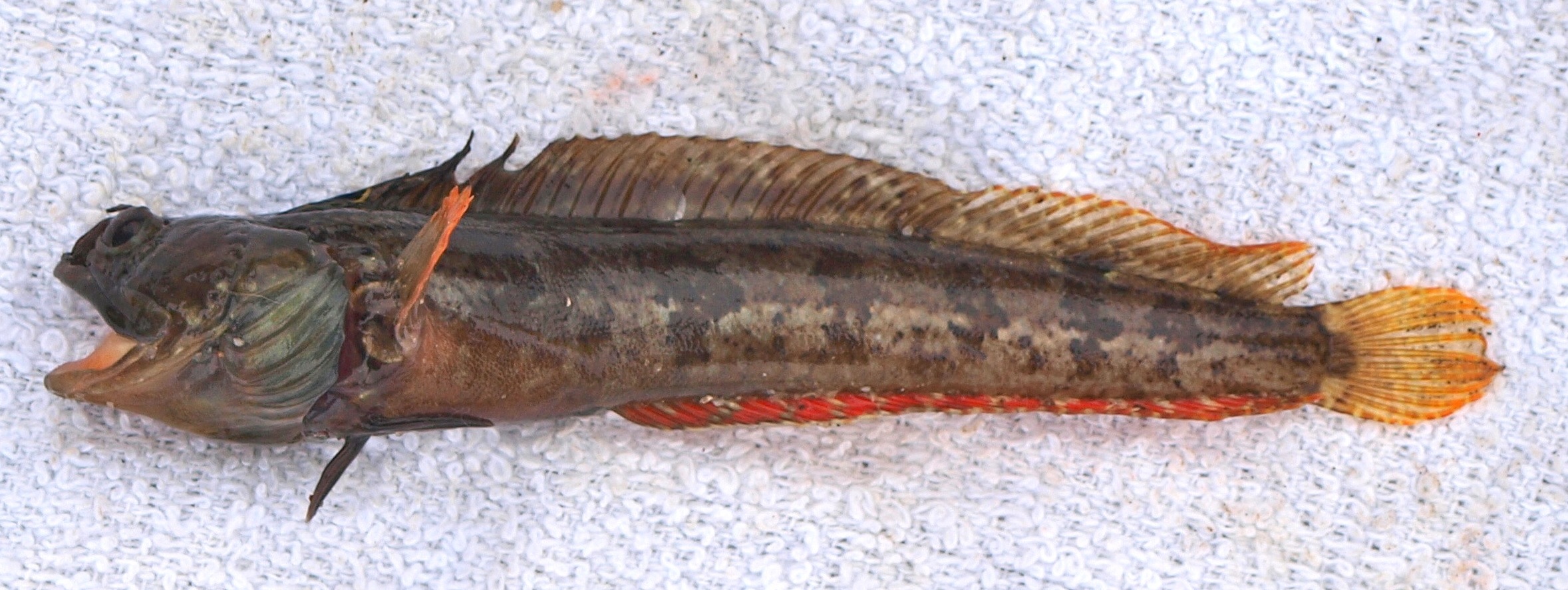
Onespot fringehead
As for the pileperch, there was a nice run going on and the locals who knew what they were doing (like Madsteelhead) were loading up on fish that weighed 1+ pounds. It reminded me of when I used to fish the Red Rock Pier in Richmond back in the ‘70s. The pier would be thick mid-winter with pileperch in the 1-2 pound range and you could fairly easily catch a limit using grass shrimp for bait. The Red Rock Pier is now history and it seems harder to find the larger concentrations of pileperch (although some areas still see good numbers). BTW, Madsteelhead also caught a nice blackperch.
There was also the issue of the sablefish. The only sablefish I have caught from a pier was at the Newport Pier and it was a long, long time ago. One day I caught 47 and one day I caught six; all were caught during very early hours when it was still dark and all were caught on squid (as discussed in Pier Fishing In California). The thinking is that these deep-water fish will come to the surface at night to feed (and young sablefish will sometimes enter shallower water). I wanted a chance at the sablefish so was back at the Wharf Sunday morning at 4 AM using squid for bait. The water was really low, the sablefish did not cooperate, and I did not catch a single one, but at least I tried.
I did have a very interesting discussion with a retired commercial fishermen the next morning, one who lives on his boat in the marina. He said a state record pileperch was caught from the wharf a few days ago, a fish which after being weighed on a couple of different certified scales weighed in at an even 2 pounds. I hadn’t checked the records lately but was a little surprised that the fish would be the record since I have seen much larger fish over the years. But, most anglers never bother to have their large fish checked or submitted as a record. He also said the lizardfish only showed up about a week ago and that there was a good bocaccio hatch showing in the water.
As for the cabezon and onespot fringehead, he had no idea, in fact he didn’t know what a onespot fringehead even looked like until I showed him a picture. He also mentioned that three sturgeon had been taken from the wharf this year along with several halibut. We had a nice long talk concerning California fishing and changes over the years and it proved a nice diversion since the fishing was a little slow (at least as far as large fish).
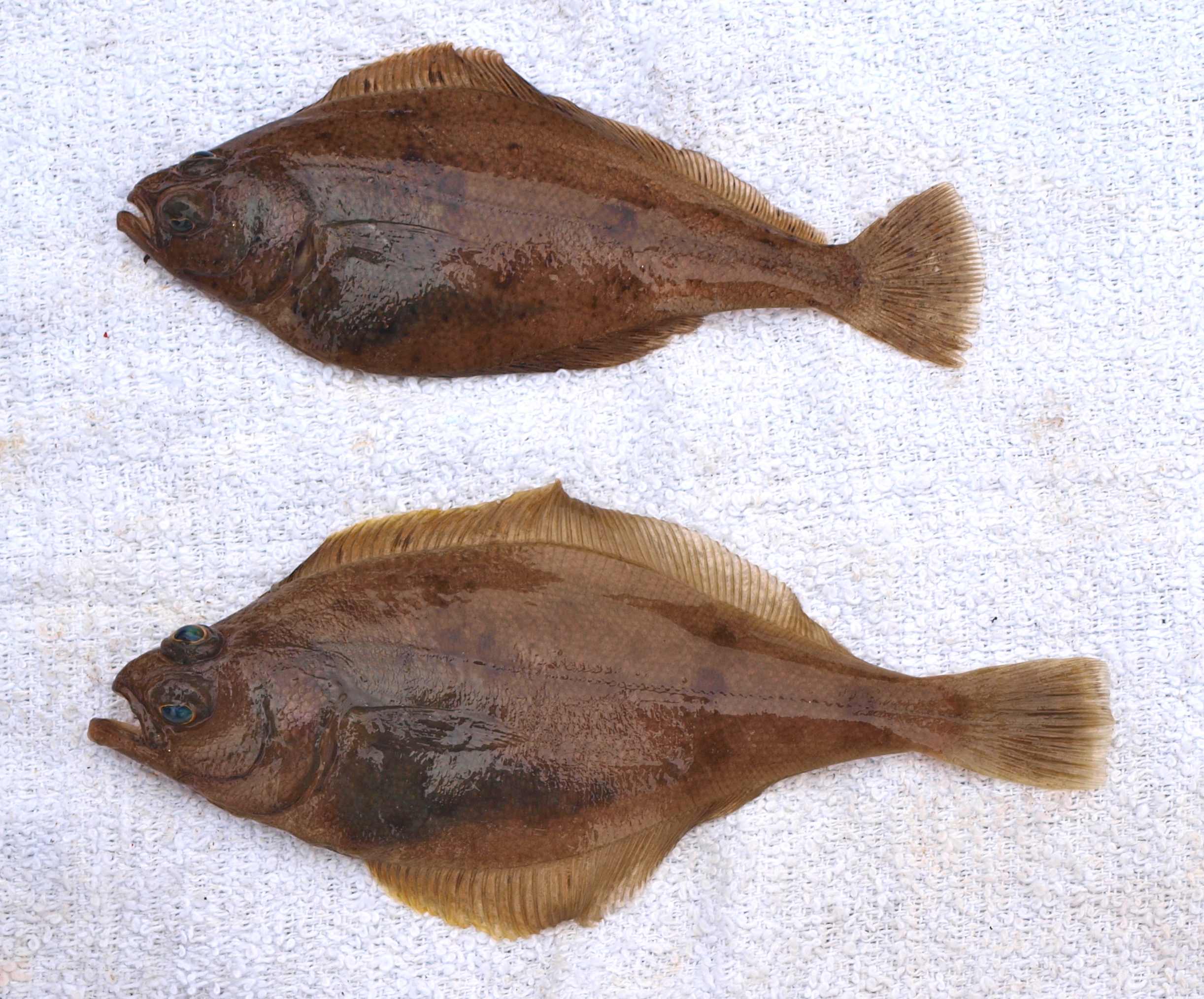
Pacific sanddab
What would prove most interesting was the number of different species that I was able to catch Saturday between two different piers—Wharf #2 and the Coast Guard Pier. Eighteen different species showed up at the two piers that day and when I checked my records when I got home it was the highest total of one day, multi-pier species. Wharf #2 (morning and late afternoon/early evening) saw California Lizardfish, Blue Rockfish, Speckled Sanddab, Pacific Sanddab, Cabezon, Senorita, Pileperch, Sharpnose Seaperch, Onespot Fringehead, Kelp Greenling, Bocaccio and Shinerperch. The Coast Guard Pier (afternoon) saw Gopher Rockfish, Black & Yellow Rockfish, Painted Greenling, Striped Seaperch, Striped Kelpfish, and what I think was a Corraline Sculpin. The 18 different species in one day from the piers was a record for me. Of course the two quite different environments would see different species but still it was a good number of different species.
I headed back Sunday at noon after a quick bowl of chowder at Fisherman’s Wharf. Three hours later I was back at Fresno and unloading the car in the middle of a 107-degree day. I think I need to find a job on the coast.
Posted by calaznfisher
Lovely read, thanks for the report from one of my favorite places to fish. Good to see you escaping the heat, and getting some productive fishing time in.
I’ve actually been keeping an eye out for sablefish ever since I read about your mirabile dictu day at Newport. According to my records, I ran into an angler carrying 3-4 medium-sized sablefish walking off of Newport pier in September of 2012. He said he caught them off of anchovies from the back right corner. No one else had caught any that I saw. Very interesting catch, too bad you didn’t see more of them.
Potpourri — Possibly more than you want to know about Monterey Wharf #2
<*}}}}}}}}}>< — In 1988 papers nationwide carried a picture of a young angler holding a somewhat prehistoric looking fish, one whose most notable feature seemed to be a large mouth full of scary-looking teeth (and its lance-like fangs provide its name). The fish was a Longnose Lancetfish (Alepisaurus ferox, meaning ferocious scaleless lizard), a normally deep-water fish that has been found down to a depth of 6,000 feet. The fish was caught at Wharf #2 and is a reminder that the wharf and these waters are fairly close to the Monterey Submarine Canyon and will occasionally yield deep-water fish.
Fin-tastic catch
What a fish story lucky Christopher Burrell can tell! The 12-year-old sportsman hooked this strange-looking longnose lancet fish off Monterey’s Wharf #2 in Monterey, California. His catch weighs 35 pounds and is more than six feet long.
—Weekly World News, May 17, 1988
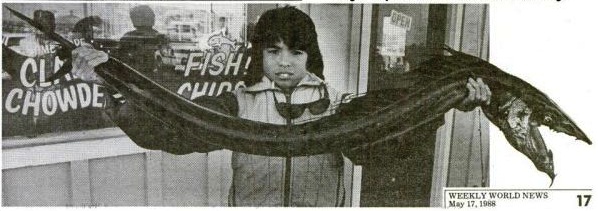
Of interest is that lancetfish are very skinny and though recorded to 6 5/6 feet in length, the listed maximum weight is 19.84 pounds. Thus the scale used to measure the fish was wrong, it was just an estimated weight, or the weight was accurate and the boy caught himself a record fish (although it does not look like a 35-pound fish).
The boy’s catch was at least the third report of the fish along the Monterey Bay shoreline at the time of the catch. A newspaper article from November 2, 1973 (The Daily Review, Hayward, California) reported, “a lancet, the sharp-toothed deep-water fish was found in a surf here recently. Robert Lea, a State Fish and Game Department marine biologist said it was only the second time in 40 years that such a fish had been found on the Monterey Bay shoreline… Lea said the 4 1/2 foot specimen would be added to the fish collection at the California Academy of Science in San Francisco.”
Apparently longnose lancetfish are common through much of the Pacific, Indian and Atlantic oceans but typically they’re found offshore in deep-waters. They are a favored food of tuna and sharks and often captured on long-line gear used for tuna. They’re hermaphrodites containing both male and female reproductive organs, and voracious eaters that will eat just about any fish smaller than them including smaller lancetfish. Given their cannibalistic bent, they will never win a parent of the year award.
<*}}}}}}}}}>< — Perhaps the best example of deep-water fish showing up at a California pier was a run of sablefish that took place at Wharf #2 in 1947. The numbers of both fish and anglers seems unbelievable—but the invasion was well documented!
Sablefish are uncommon to California piers but when they do show up it’s typically at piers located next to deepwater submarine canyons—those at Newport Beach, Redondo Beach, Moss Landing and Monterey. I’ve been lucky enough to catch them at the Newport Pier twice, 47 on September 10, 1962 and six more on October 27, 1962. And though I have caught many whole fishing the deep-water reefs out of Santa Cruz for rockfish, I’ve only seen one other one at a pier—July 20, 2013 at Monterey’s Wharf #2.
Sablefish Run At Monterey Bay
For the first time in history, sablefish (Anoplopoma fimbria) appeared in vast numbers in the vicinity of Monterey and were caught by the thousands from the municipal pier. The run was first discovered on the afternoon of July 11th; word of the bonanza spread rapidly, and the pier was soon crowded with anglers. Men, women, and children stood shoulder to shoulder, with a varied assortment of tackle, all hauling in fish as fast as they could throw in their lines. Boxes, sacks, five-gallon cans, and washtubs were rapidly filled with 12 to 20-inch fish. Slack periods occurred during the morning and again in the afternoons, but they were of short duration usually lasting only half an hour or less; then the fish would be back seemingly in greater numbers than before. Each day the pier would be jammed with crowds of from 2,000 to 3,500 fishermen and spectators, some having driven as far as 200 miles.
On July 26th, the run stopped as abruptly as it had begun, and although over 5,000 fishermen were on hand the next day, only a few fish were caught. During the 15 days of the run, the Bureau of Patrol Division of Fish and Game, estimated that over 110 tons had been landed.
— Keith W. Cox, Bureau of Marine Fisheries, California Division of Fish and Game, September, 1947
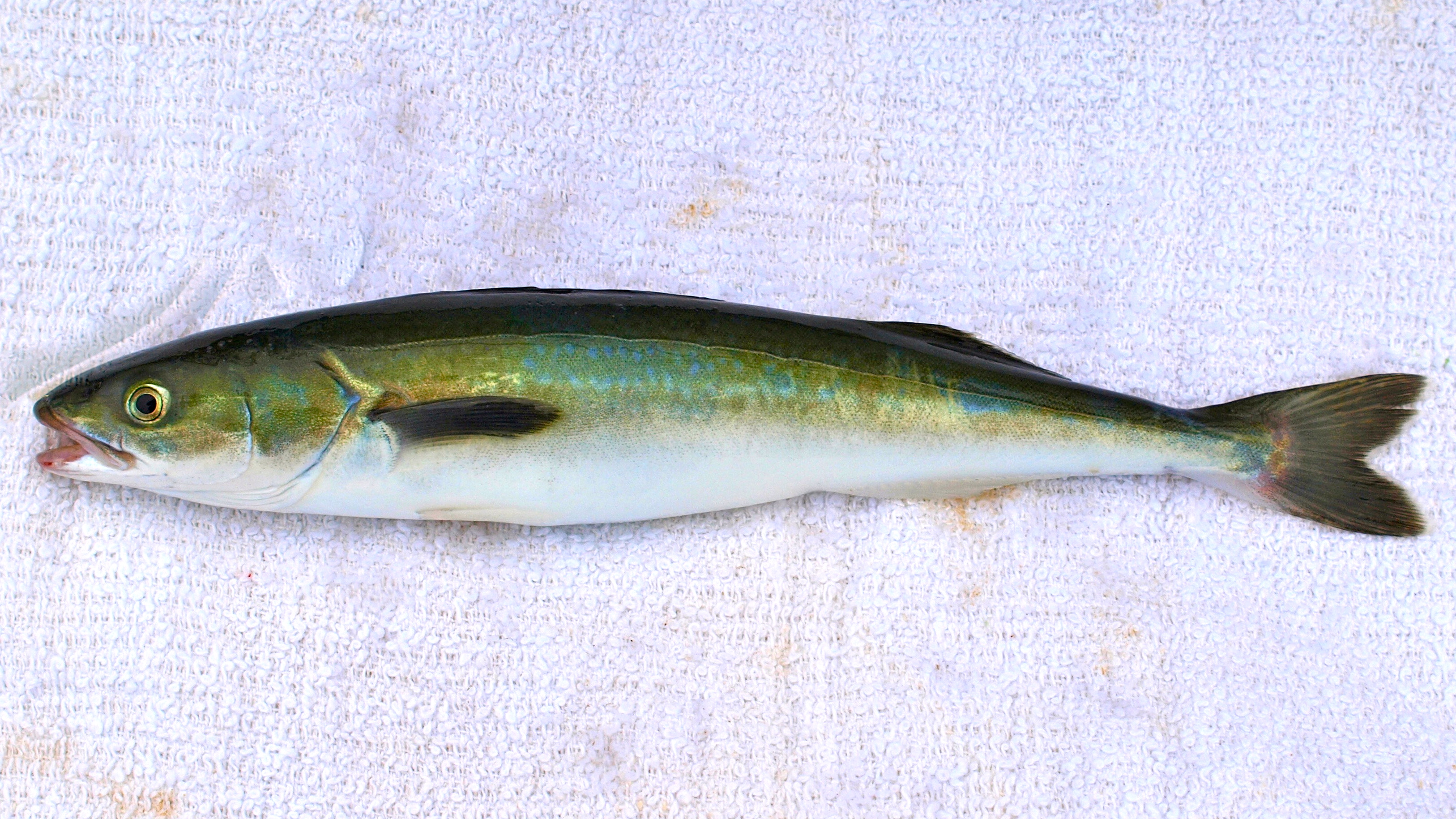
A juvenile sablefish caught in 2013
<*}}}}}}}}}>< — Some interesting old newspaper reports on fishing at Monterey.
Fishermen — From a Mr. Turner, who is stopping at Pacific Grove, two miles from Monterey, it is learned that six salmon were caught in the bay by trolling… The same gentleman reports that bonitas have been unusually plentiful and that baracouta are not infrequently hooked. A few mackerel are also said to have been caught from the wharf at Monterey.
—San Francisco Chronicle, August 7, 1883
Swarming With Fish — Unusually Large Number in Monterey Bay
Pacific Grove.—For several weeks Monterey Bay has been fairly swarming with fish. This bay is noted for its varieties of fish, nut never before have so many been caught. The season of mackerel has been unusually long. Some of the big mackerel have weighed from 200 to 500 pounds. The sardines are so numerous that they can be seen spinning all over the surface of the water and can be caught in bucketfuls from the wharf and along the beach. The pelicans and sea gulls are having great feasts.
— Santa Cruz Sentinel, November 5, 1895
Big Fish Caught at Monterey
Monterey.—Manuel J. Silva, a fisherman of Monterey, harpooned a large tunny (giant mackerel) near the Pacific Coast Steamship Co. wharf Sunday afternoon. The big fish was a fighter and dragged the boat some distance befor it was finally killed. The tunny weighed 310 pounds.
— Santa Cruz Sentinel, December 31, 1896
Run of Fish at Monterey
Monterey,—Horse mackerel are having a great run in Monterey bay, being so plentiful that they are easily caught with grabhooks from the wharf. Fishermen are having an unusually profitable season because of the variety of fish. Large shipments of sea bass, mackerel, pompano and barracouta are daily sent to San Francisco.
—Santa Cruz Sentinel, November 13, 1897
Rare Fish at Monterey
Monterey.—Silver mackerel are beginning to appear among the fish brought in by the fishing boats of this place, and the fact is causing great interest among fishermen hereabouts. It is said by old salts that this beautiful fish appears in California waters only once in every hundred years and always means prosperity to fishermen. It is really a rare fish, and its presence now is exciting considerable interest among the townspeople generally.
—Santa Cruz Sentinel, January 30, 1900
Neal Dow, 13, … pulled a 44-pound halibut onto the new Monterey wharf after a healthy struggle that had the other fishermen cheering.
—Ernest Otto’s Waterfront, Santa Cruz Sentinel, September 1, 1939
Holy Mackerel! What Crowds Going After The Mackerel
Biggest crowds in years are jamming the Monterey wharf these days, angling for the easiest mackerel catches in years. The run is practically unprecedented in this section, and fishermen are hauling them in at a great rate. The word has spread to such an extent that a special police detail has been stationed on the pier to keep order and to keep the anglers from doing damage. Crowds are so thick that police report several car windows have been smashed by high-flying sinkers. Both Spanish and horse mackerel are plentiful. Several local fishermen have tried their luck and they say the fish are not only plentiful, but are heavy. The run has been on for a week and shows no signs of slowing up.
—Santa Cruz Evening News, September 4, 1941
<*}}}}}}}}}>< — I previously mentioned the pesky, bothersome, bait stealin’ senorita and I wasn’t kidding. An early June day in 2002 saw me make a visit in pursuit of perch. I hoped to find some big perch and, if I was lucky, I hoped to run across a school of the elusive sharpnosed seaperch. I’d gotten an Email message from AvidAngler that the perch were hittin’ so traveled down on my birthday to make a visit.
But I would have to deal with the senorita first. I had my rigging set, my pile worms were fresh, and I dropped the line into the water. Many times perch are on the bottom but sharpnose perch and rubberlips, the two species I was targeting, are often found mid-depth. That’s where I dropped my line, down about eight feet or so next to a piling and I immediately began to get tap after tap.
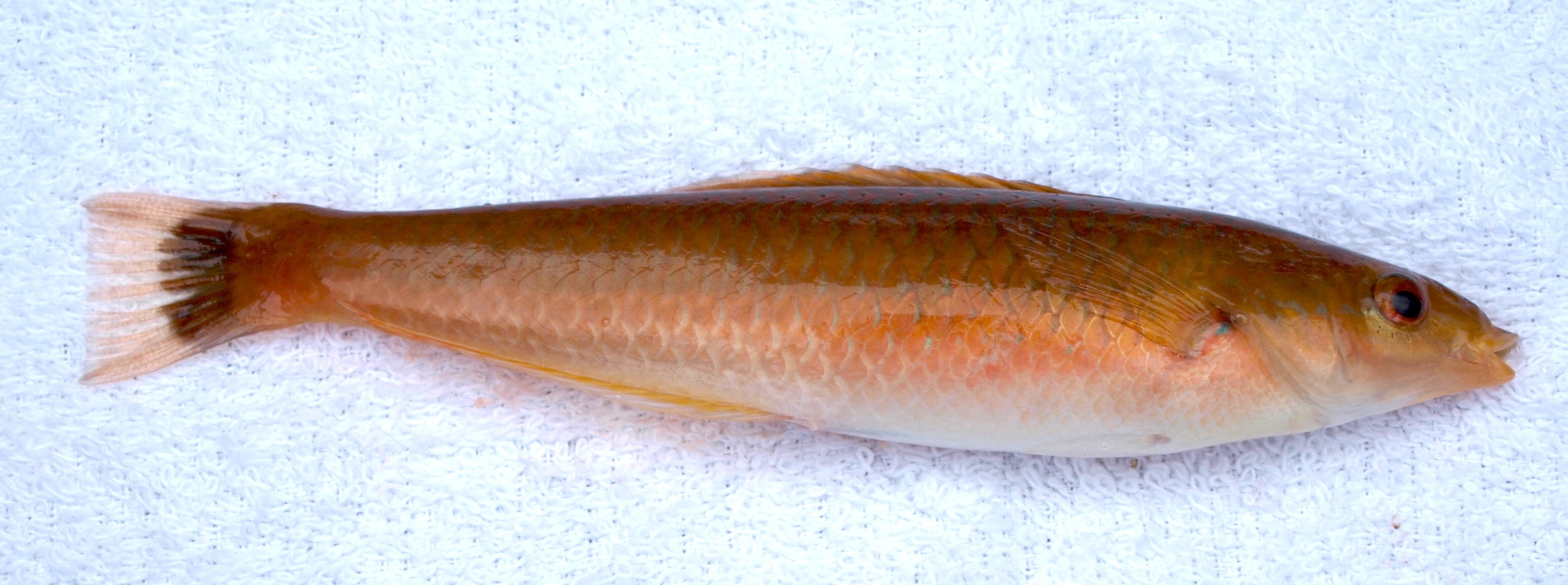
Senorita
Perch will often tap the bait but usually the second or third tap will result in a hookup. What was happening here was an assault on my bait, a quick stripping of the hooks, and a need to rebait. After this happened a few times my suspicions were confirmed as to the assailants when I hooked and pulled in an 8-inch senorita. Senorita love pile worms and find them especially easy to remove from a hook. In fact, they find any soft bait easy to steal. Nevertheless, when I did manage to pull in a sharpnose seaperch a few minutes later I felt confident as to my bait and technique. But, I also knew that the small pieces of pile worms would attract the senorita along with the perch. I guess it was sort of an occupational hazard if I wanted to be a perch hunter.
Eventually the worms were gone and I switched to strips of squid (which were also attacked by the senorita) but I did manage to land two of the sharpnose perch along with two-dozen or so senorita. I also checked out the bottom and it seemed as the morning progressed, the senorita went from being primarily at a mid-depth region to covering the water from the bottom to the top (perhaps they were simply adjusting their normal pattern because of the bait I was feeding them). I did manage a good-sized rainbow seaperch using the squid on the bottom, along with a small kelp rockfish, but the senorita made me work for the “better” fish. Some say senorita are tasty but all were returned to the water. Perhaps they will get a taste test some other day?
<*}}}}}}}}}>< — The yin and yang, bad or good nature of the pier, really stands out in a sequence of visits that saw two 0 fish, skunk days, sandwich between two 100+ fish days. The first day (October) saw Pacific mackerel and jack mackerel running at the pier and saw a total of 150 fish caught in just two and a half hours. The next two trips, in July and November the following year, produced no fish. In fact, not even a bite. However, those fishless days were followed by a July visit the next year when the sea’s floor seemed to be covered by lizardfish and assorted other species while mid-depth waters were saturated with small rockfish. The result was 154 fish in just under seven hours of fishing. I’ve averaged 12.2 fish per hour at the pier due to the large schools of small and medium-sized fish that sometimes visit the pier—Pacific mackerel, jack mackerel, Pacific sardines, juvenile bocaccio, and lizardfish, yet if you visit the pier when schools are absent you can go fishless in Monterey. You just never know although if the pier is devoid of anglers when you arrive, the fishing is probably slow (or dead). When fish are present, word seems to get out very quickly and the pier will be filled with anglers (darn cell phones).
<*}}}}}}}}}>< — To really get to know a pier, and to have the opportunity to experience a “big” day, it pays to fish the pier often. The following comes from the autobiography of avidangler (Robert Ford), once a regular at this pier and a reporter for the PFIC Message Board. Most Memorable Pier Fishing Trips (and Why): “One year the stripers came to Wharf #2. They were so thick you couldn’t miss, for about a month. One evening I hooked nine in a row off Pencil Poppers, one of the best days I have had anywhere! Last year we made front-page news when salmon showed up in incredible numbers. I landed 20 one day (no kidding). Everybody was hooking fish. It was much like Pacifica. But I would have to say that my first steelhead rates as the most memorable. The 1/2-ounce Krocodile spoon has since been my favorite pier lure. It works.”
<*}}}}}}}}}>< — From the CA Fish and Game Dept., Administrative Report No. 82-9, Species Composition and Catch per Unit of Effort of Monterey Bay Surf, Pier, and Skiff Anglers in 1979: “In 1979, Monterey Bay sport anglers were sampled for species composition of the catch and catch per unit of effort. A total of 4,150 surf, pier, and skiff anglers were interviewed.
Fish per hour was… .58 for piers. The species composition of the pier catch was dominated by juvenile bocaccio, Sebastes paucispinis; white croaker, Genyonemus lineatus; and the walleye surfperch, Hyperprosopon argentum… Monterey Wharf No. 2 (1.55 fish per hour) was the best public fishing pier. However, a small privately operated pier inside Moss Landing Harbor had the best catch rate (2.44 fph) of all piers sampled… Santa Cruz was the poorest fishing pier with a catch rate of 0.32 fph.”
However, the report goes on to state that a DF&G study in 1968 by Miller and Odemar had almost the opposite results: Santa Cruz was the best fishing pier (1.25 fph) and Monterey Wharf #2 was one of the poorest (.50 fph).
The contradictory results reflect the nature of Central Coast piers that can have a very high or poor catch rate dependent upon the arrival of certain schooling species—sardines, jack mackerel, Pacific mackerel, jacksmelt, walleye surfperch, shinerperch, bocaccio (nobody knows for sure if these baby rockfish will ever reappear in their once substantial numbers.), and increasingly, lizardfish The DF&G results by the way differ substantially from my personal results (1975-2014): Monterey Wharf #2 (12.2 fph), Santa Cruz Wharf (8.33 fph).
<*}}}}}}}}}>< — Poaching is something that goes on at piers and especially at piers that see as much use at Wharf #2. A natural question that arises is when poachers should be confronted—and how. The following was sent in by one of my friends, James Liu. James was a longtime member of the United Pier and Shore Anglers Board, an excellent fisherman, a Boy Scout leader, an intellectual giant (two PHD’s in nuclear physics), and one of the finest men I have ever known. James was a large man with a large heart and was not hesitant to confront poachers. James was born in Taiwan and he especially objected to poachers who were Asian because, as he once explained to me, he had personally had to face discrimination so many times growing up due to the poor actions of others. He hated the perception by many that all Asians break the angling rules and he tried to teach as many people as possible the proper and legal ways to fish.
My first exposure to his “power of persuasion” occurred one night when we were fishing at the Green Pleasure Pier in Avalon and two young (Asian) men were illegally hooking and keeping lobsters. Other people tried to get them to stop with little success while James got them to stop and got them to return the lobsters to the water. How? By explaining to them how their actions made him look bad. James was a person who was always willing to walk the walk as well as talk the talk. James died in 2013 and will always be sorely missed.
Date: August 2, 2003; To: PFIC Message Board; From: gyozadude; Subject: Monterey Municipal Wharf — Poacher’s Tale
I found myself groggy, but awake at 5am this morning trying to finish some work, only I was in Monterey, staying not far from the Wharf. So I got off some email and headed out for a short walk at 6am this morning. I thought I’d try to catch the slack low tide in the early morning.
Well, I tossed a chromed Buzz Bomb with a single shank barbless hook for about an hour off the east side of the pier and hiked up and down. A few regulars there cussin’ to themselves or using it to pick up some down-n-out ladies hanging out in their beater cars on the wharf.
Passed by a bunch of Vietnamese fishermen with 9-ft Ugly Stiks fishing Sabikis without much luck near mid-pier. More hung back in their minivans, smoking and watching for any signs of fish. I asked the guys standing outside if they were seeing any runs. No, one guy responded with a smile. But they were watching for anyone, smiling at me. One guy commented that it had been dead for the last few days. No bait, no big fish. The guy cussin’ profanity every sentence said he’d, “What da f—sh–yu tellin’ ‘im? I seen 3 already right here… F—!”
They gave my gear the once over and took notice of the chromed Buzz Bomb, but didn’t say anything.
I walked on toward the end of the pier and fished close to the zone that had a sign that read, “No Fishing Beyond This Line.”
I passed by a middle-aged Filipino man fishing pile worms on a hi-lo, and saw two Vietnamese guys fishing, one of them on the other side of the line in a “No Fish” zone. A younger guy, a mixed Caucasian/Asian guy, around 20-something and maybe just short of 6 ft tall was fishing the west side of the wharf.
Nothing but seals and sea lions, and weeds for the hour I tossed.
Finally, the Filipino man hauls up a 5” rockfish. The young guy and I walk over and see what it is. From a distance I already suspected it was a small bocaccio. It was throat hooked. The old Filipino man complains that it’s throat hooked. The younger guy offers his multi-tool (Leatherman style tool) for the hook extraction.
I commented to the Filipino, “Sir, that’s a bocaccio, and currently restricted. No bocaccio can be kept. Since it’s throat hooked, the standard procedure is to cut the leader as close to the hook as possible and release the fish.”
The young guy looks at me and asks, “how do you know it’s a bo-ka- what?”
“BO-ka-CHEE-O,” I emphasized. “See, the brownish tint, large mouth lip plate that extends back behind the eye, and the prominent lateral line that is curved up and back. Bocaccio are one of four rockfish closed to all take by Fish and Game regulations section 26.85.”
I walked away from the two and went back to tossing my lure around. A Young kid walked to the end of the pier and was asking anyone if they caught anything. He stopped for a while to observe the two guys doing the hook extraction. They hadn’t listened to me. They still took the hook out. And at that point, the older Filipino man bagged the bocaccio.
So back I went toward the man, and I pulled out my dig-cam and snapped a shot of the guy. He had that puzzled look on him.
In clearly stated terms, I spoke to him, “Sir, Fish and Game regulations prohibit the take of Bocaccio. I told you that before, and you knowingly broke the law.”
“What law?!?” he demanded vehemently. “I, I throw it back, okay?”
I said to him, “Section 27.82 of the regulations define rockfish closures and, Sir, section 1.87 prohibits the waste of fish. You may throw the fish back, but it was gut-hooked and now, its chance of survival is quite low since you ripped its guts out extracting your hook.”
The young kid started to pay some interest, as we were getting a little loud.
“What are you going to do with the picture?” he demands in a threatening tone.
“Oh, the picture? I’m going to send it to DFG.” I tell him.
“You violated my privacy… you can’t do that. I didn’t know the law! … Hey, where you live? I find your address… and you watch out! This is Bullsh–!!! You are full of bullsh–. I know no laws. You violate my privacy… I’ll get your license plate…” he threatens.
So I stepped up to him and clearly asked him. “Sir, is that a threat? Are YOU THREATENING ME?”
He was fuming at this point and I had my hands in my pockets on my cell phone. But he didn’t know that. “Uh… no… but you have no right to take my picture.”
“Sir, you’re standing on public property in the open. Anyone can take your picture…” I explained.
“You bullsh–… and stop calling me sir… go ahead call the cops. I take your picture TOO! You’re in violation. You bullshit too. You in violation. I don’t know the law…,” he yelled at me… (and I’ve paraphrased some statement which would be inappropriate for this forum.”
“Well, sir, ignorance of the law is no excuse,” I told him.
After a minute of his nagging, I walked away and back toward the foot of the pier to head back to the hotel. He shouted at me as I walked away, “You think you smart? You da one ignorance. You bullsh–!!! You da ignorance… I find your address.”
Anyway, I walked back down with the young boy who was asking me about more details. His dad had a boat and he was waiting to head out with him fishing, but they weren’t ready yet. We stopped about mid way and I called 1-888-DFG-CALTIP. Wow! A human answered, and I filled out a report. Didn’t think they would scramble any units, but I did my duty.
The young man asked why bocaccio were closed and I explained that they’re closed so stocks can rebuild for fishing, so folks like my kids, and him can grow up and still have bocaccio to catch. Then it was his turn to look puzzled. Well, why did that guy have to steal fish? I just love it when kids can figure out that poaching is wrong!
Epilogue: The poacher took off in a hurry. Paul Gaske from DFG enforcement called me and we talked for quite sometime, and he might show up on this website. I told him about some UPSAC activities and we’re hoping to have another person involved in our education efforts! Not all skunked this morning.
P.S. Picture of poacher to be posted later when I get the USB cable for my camera or the adapter/reader (both of which I left at home)
Addendum: (In reply to: Re: Monterey Municipal Wharf — Poacher’s Tale posted by urge2fish on Aug-2-03 11:04am)
I wasn’t quite alone. I had a young boy who was a witness. Also the young mixed Asian/Caucasian angler in his early 20’s who initially offered his Leatherman-style tool to do the hook extraction. He distanced himself pretty quick from the poacher when he realized that he may have helped some poacher keep and illegal fish and I was going to call it in.
At night somewhere in East Palo Alto? Heck no. No bein’ a hero for me. But in Monterey? With lots of tourists, hikers, and folks already on the beach and pier at 7am? Yeah, I think it’s viable. Every situation is different. And it was a judgment call. But look at the pic. Was it worth it? Heck yeah.
Reminds me of a credit card commercial. A cheap department store combo: $60. Terminal tackle: $2. Pile worms: $4. Getting ratted out by a big Chinaman who knows the regs: $790. Getting caught on dig-cam as a poacher and having it posted to the net: $Priceless.
<*}}}}}}}}}>< — This wharf as well as the adjoining wharf—Fisherman’s Wharf—has appeared in many movies. Those specific to Wharf #2 include Captains Courageous shot in 1937. Scenes included two schooners tied up to Wharf #2. They Drive by Night was filmed in 1940. Several other movies were filmed in the harbor and at Fisherman’s Wharf and may contain scenes or shots of Wharf #2; they include A Woman of the Sea/The Sea Gull (1926); Tiger Shark (1932); I Cover the Waterfront (1933); Mutiny on the Bounty (1935); Captain January (1936): Edge of Darkness (1943); In Love and War (1958); and The Candidate (1972). Some sources say that See America First (1915) includes shots of sea gulls at Wharf #2 but considering the fact that Wharf #2 wasn’t built until 1926 that idea seems just a tad bit unreasonable, even if it is the movies. Maybe Fisherman’s Wharf?
<*}}}}}}}}}>< — Fisherman’s Wharf sits just across the parking lot from Wharf #2 and is a must visit spot for most visitors to Monterey. It is slammed at times for its tourist glitz but I’ve always enjoyed a stroll on the wharf and have had many a fine meal at its restaurants.
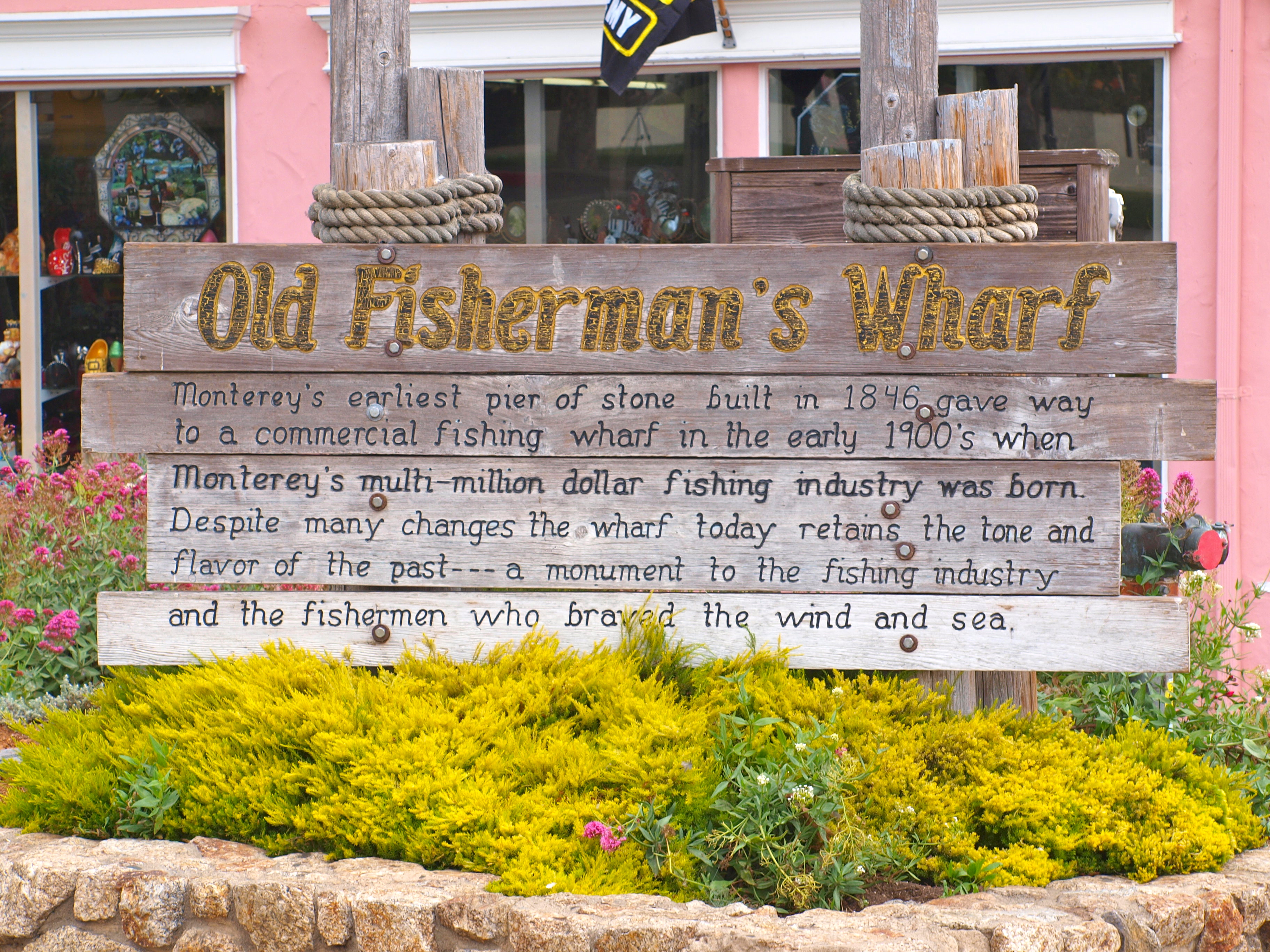
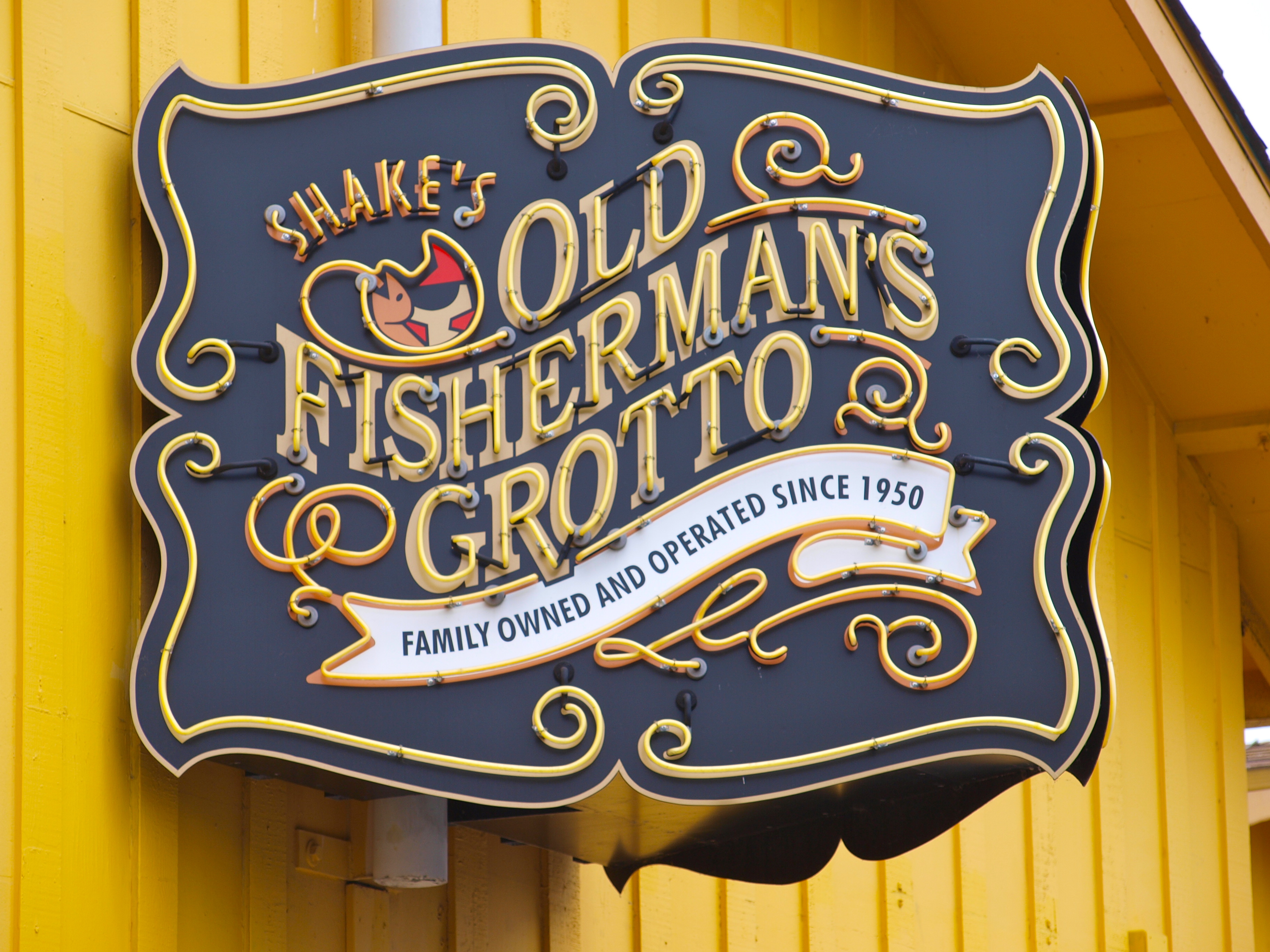
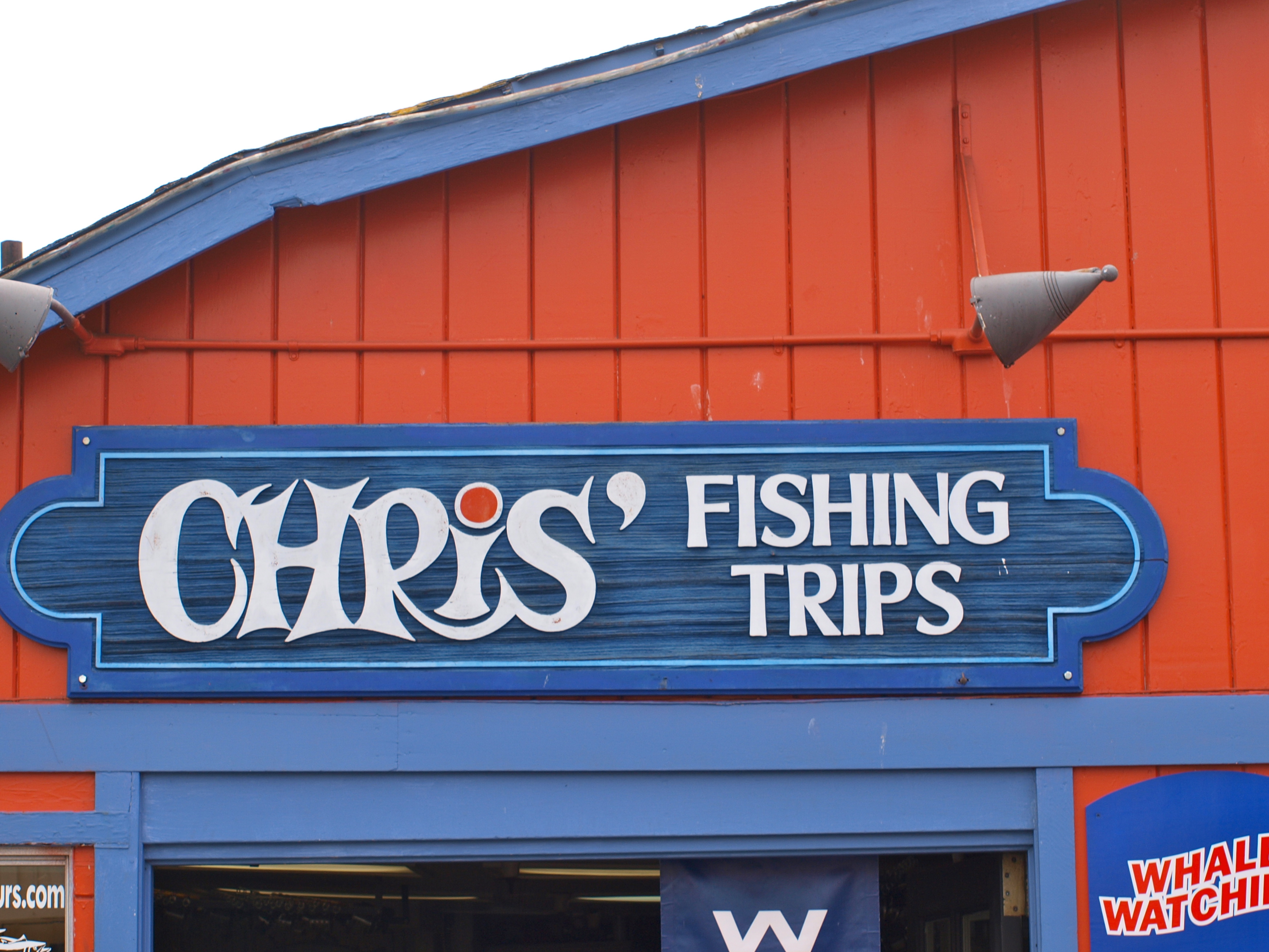
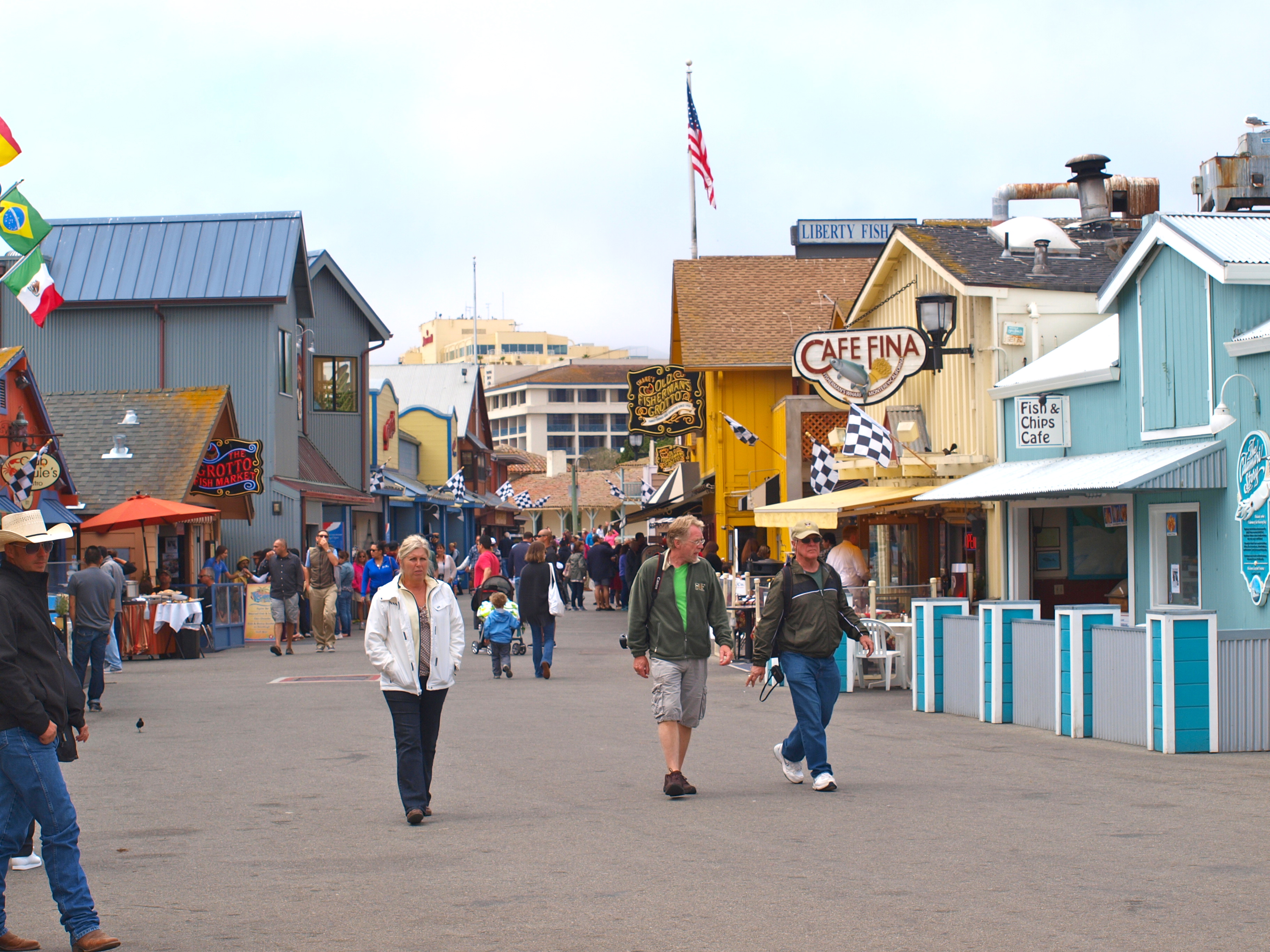
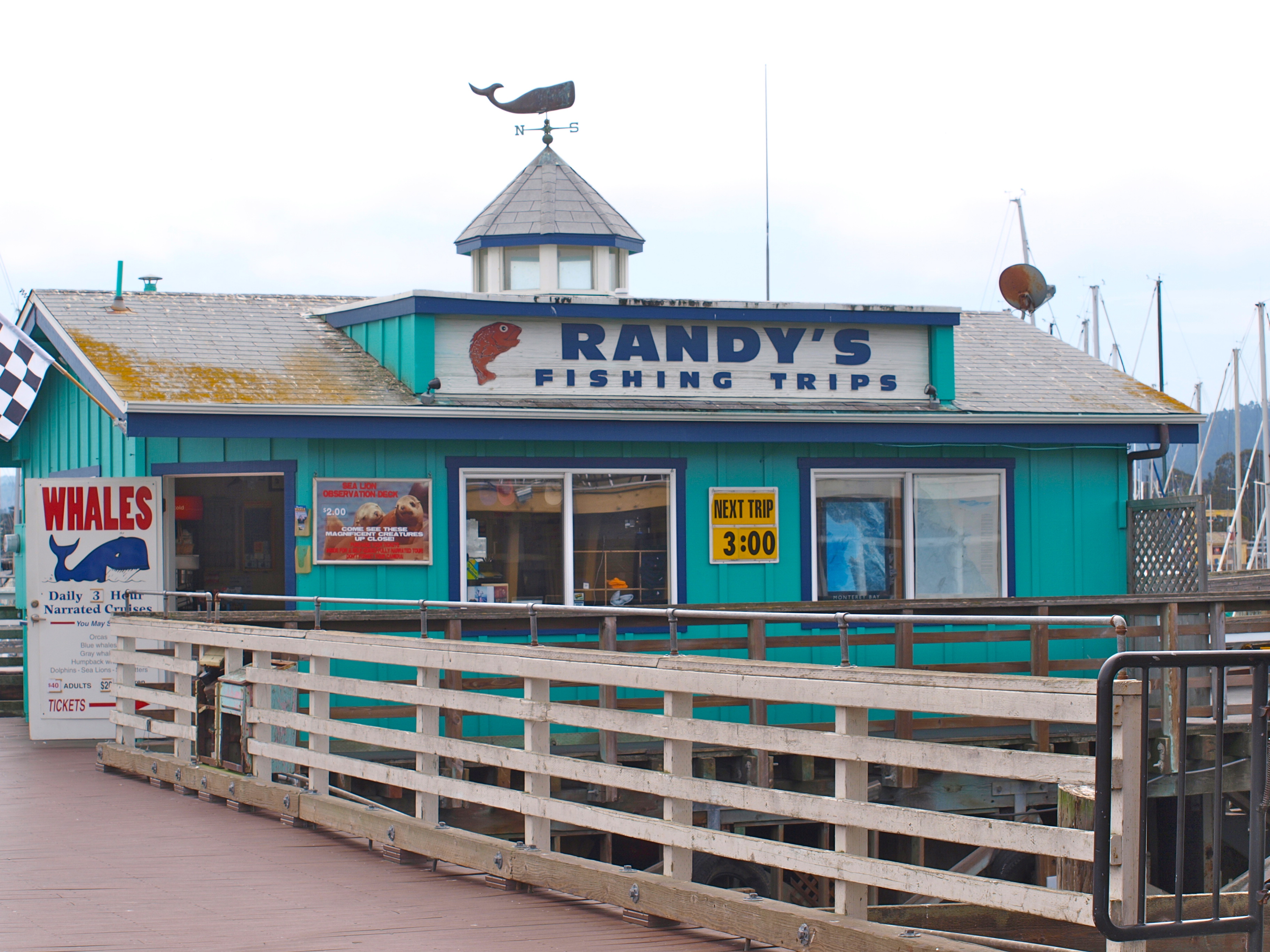
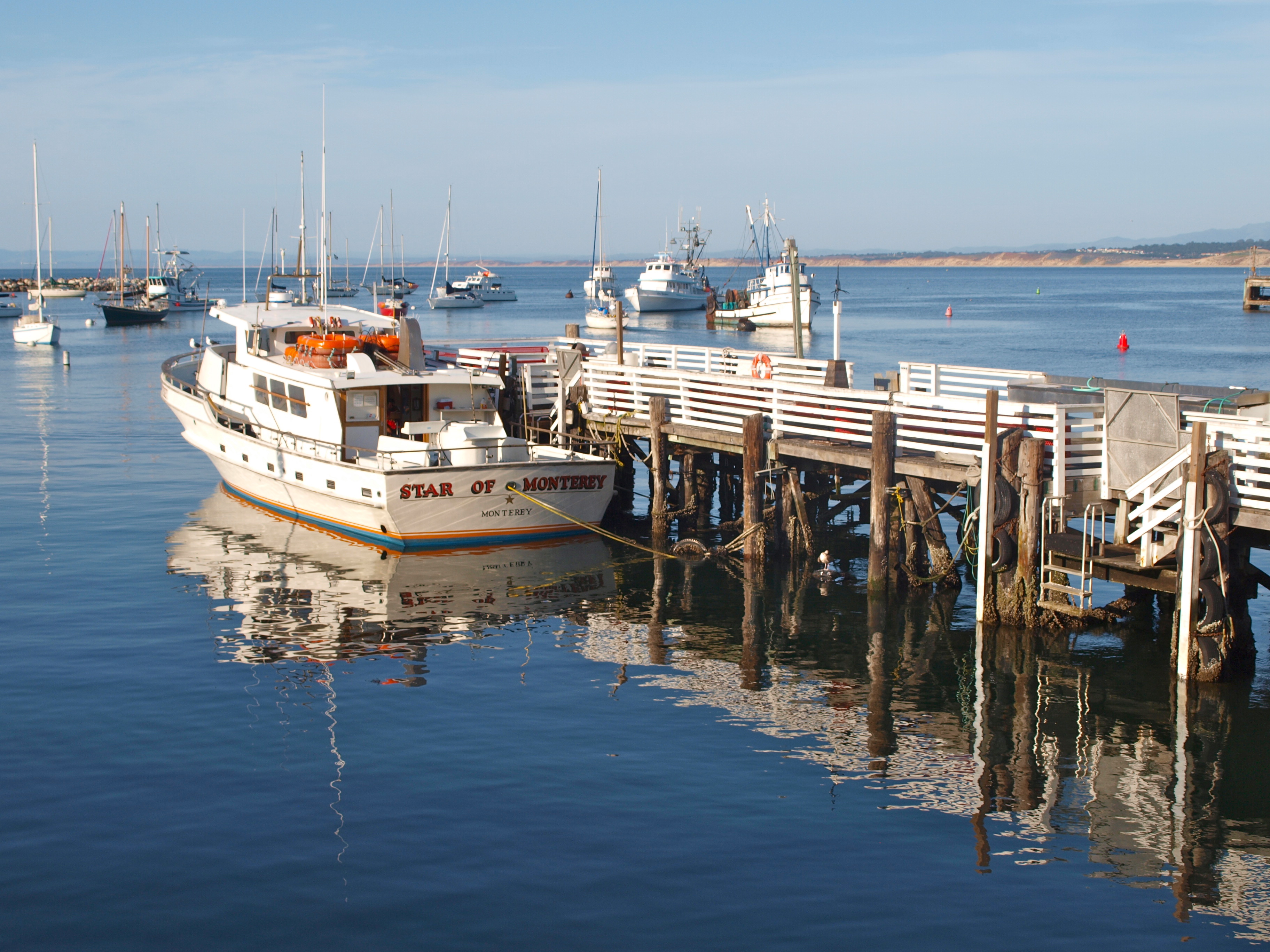
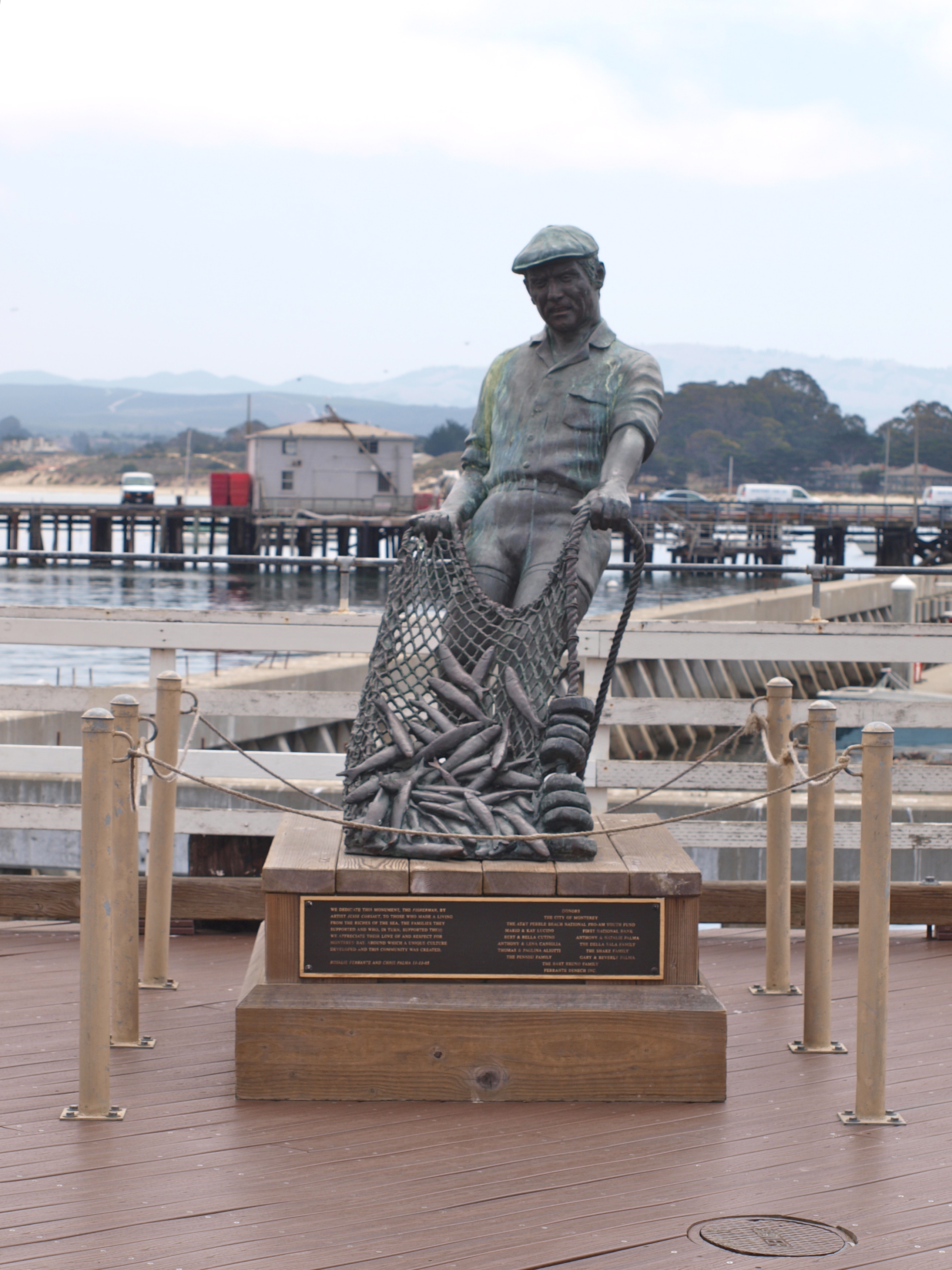
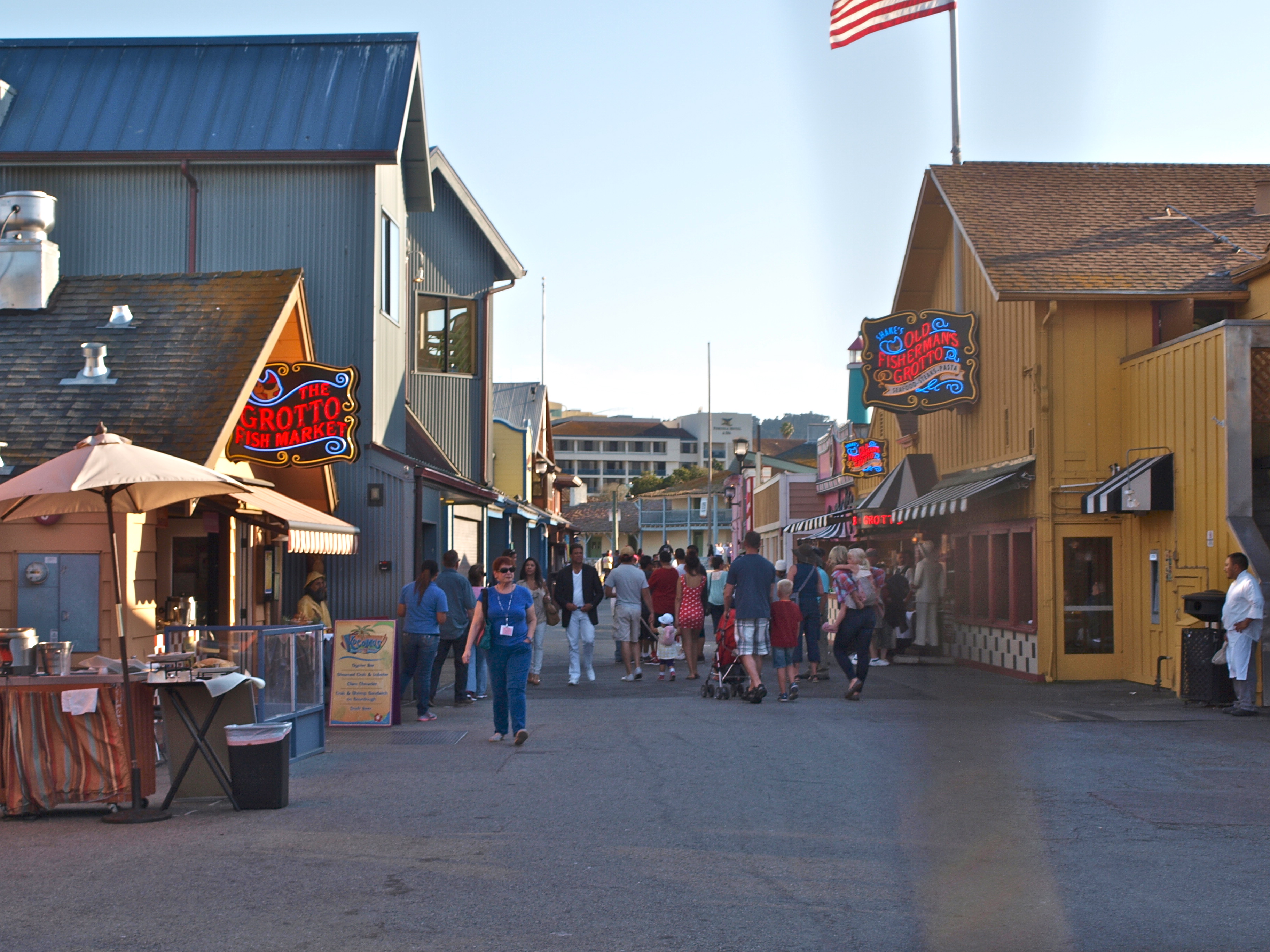
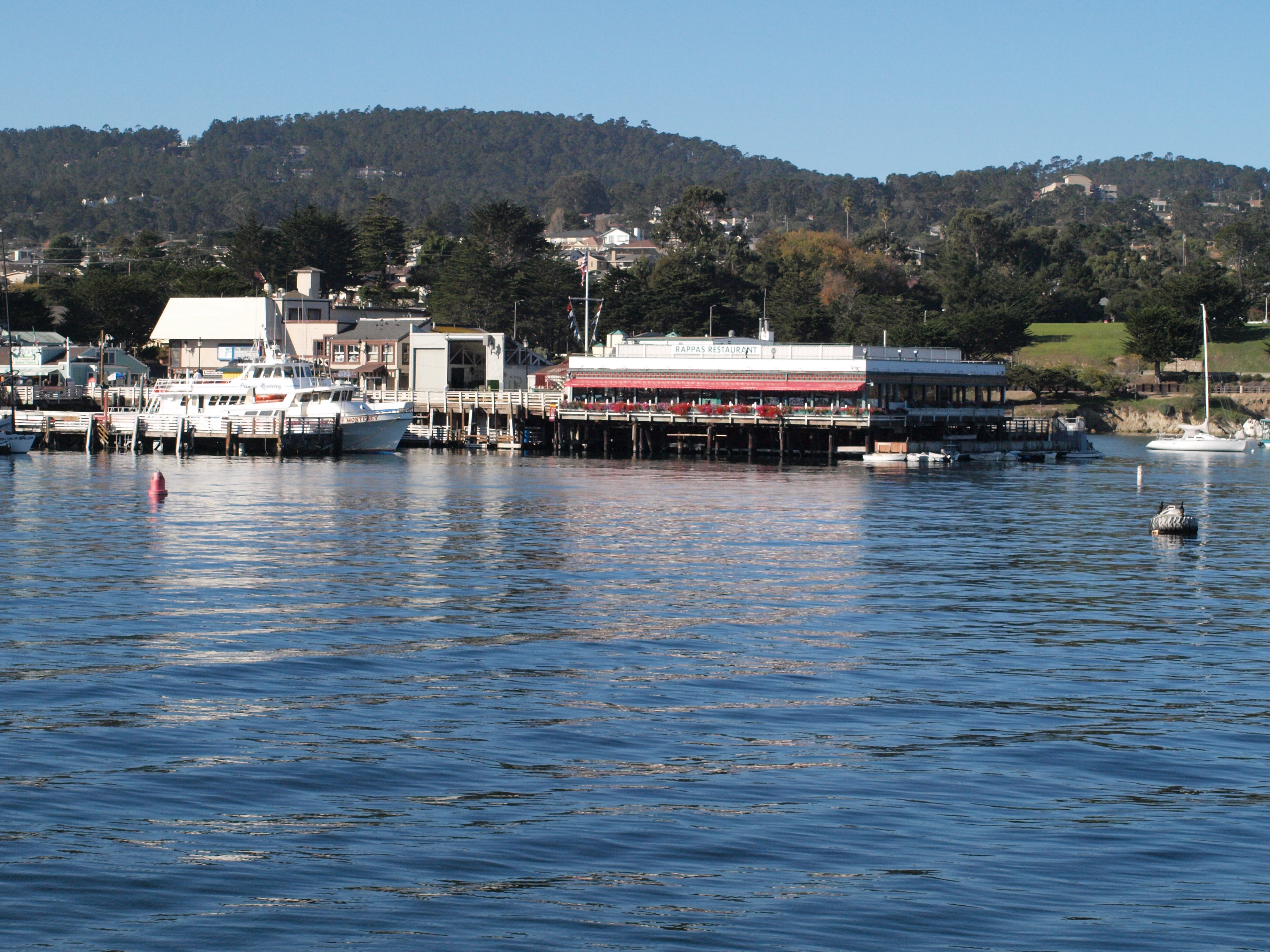
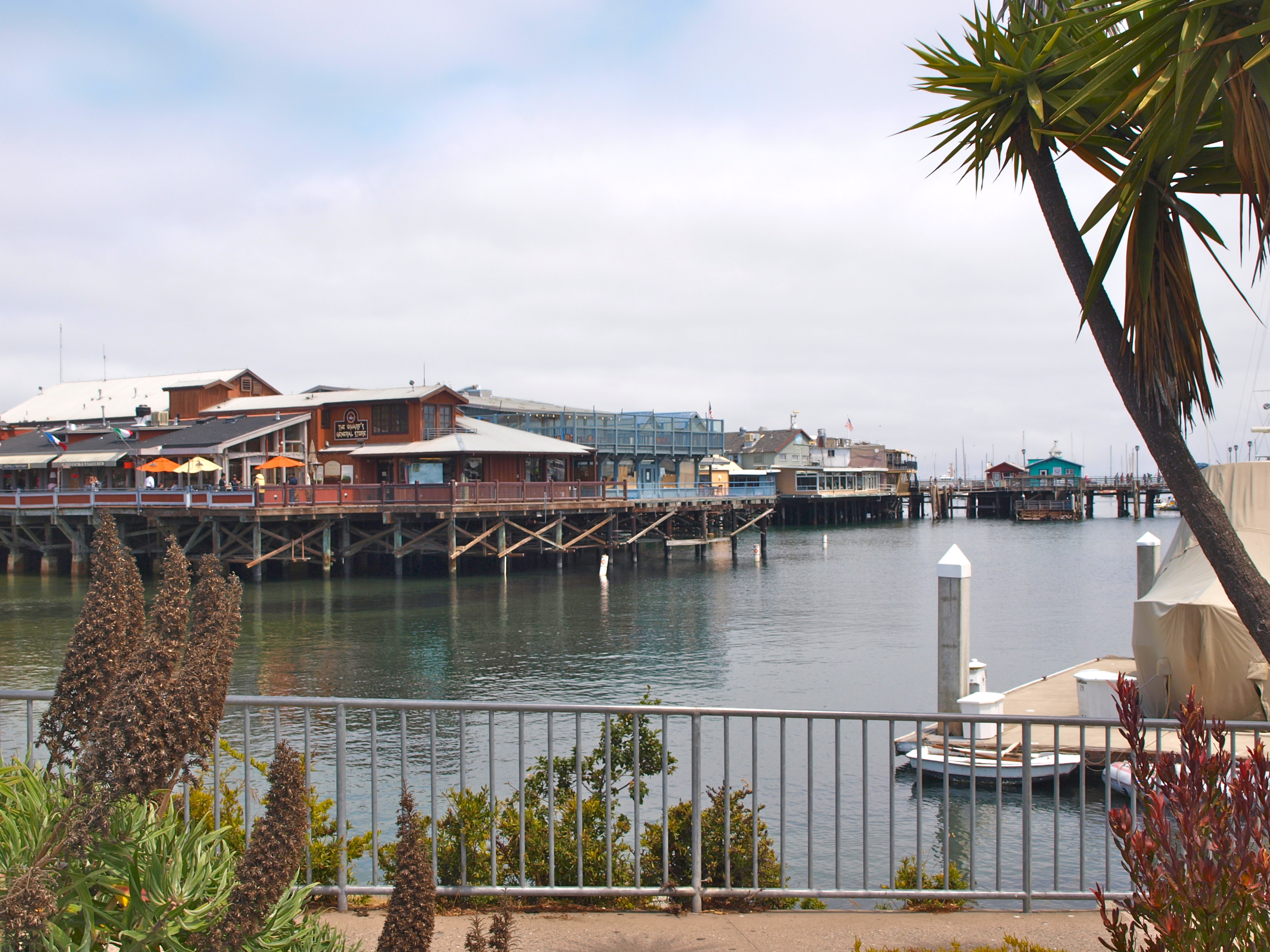
History Note. Monterey Bay was originally discovered by Cabrillo on November 16, 1542, and given the name Bahia de los Pinos. Cermeno crossed it on December 10, 1595, and called it San Pedro (in honor of Saint Peter Martyr, whose feast day is December 9). Seven years later, on December 16, 1602, Vizcaino anchored in what today is the harbor and named it Puerto de Monterey, in honor of Conde de Monterey, then viceroy of New Spain.
Over the years several different wharves and piers have graced Monterey’s coastline providing a means of transportation, as well as commercial and recreational opportunity. Today, the railroads and the wharves they used for transportation are gone. So too are the canneries with their round the clock activity and smells that made the area famous or perhaps more appropriately infamous. Commercial fishing boats still operate from Wharf #2 but the numbers seem to decrease each decade. Recreation though remains strong for the three types of local angling—recreational party boats, private boaters, and shore-bound anglers. Luckily there are still some fishing piers—but once there were even more.
___________________
California’s first oceanfront wharf, in fact its first wharf, was built in Monterey Bay in 1845 by Thomas Larkin. At the time, Monterey was still the Mexican capital of Alta California and most citizens agreed a wharf would be a useful improvement for the town. Larkin, one of Monterey’s leading businessmen, and one of California’s first entrepreneurs, decided to build the wharf. The wharf was built under contract with the Mexican administrator of the customhouse and though Larkin eventually asked the Mexican government to repay the $8,200 cost of building the wharf, he never received the money. Larkin would later serve as the first and only United States consul to California.
In 1846, during the war with Mexico, American forces commandeered the wharf (for use by both the Army and the Navy). The next year, after acquisition of California by the United States, Larkin sought to have the American government either buy the wharf or return it to his control. If returned, he planned to bill the government for its use of his wharf. Initially both the Army and Navy seemed to ignore his claims. After receiving what he felt was a run around from Naval personnel, he contacted the Army. General Stephen Kearny, who had assumed command of both military and civil affairs, rejected his claim and suggested he contact Naval Commodore James Biddle. Larkin’s claims that prior Navy personnel had promised to purchase the wharf seemed to fall on deaf ears when Biddle suggested he should once again contact the Army since they might want the wharf.
Back went the case to the Army, which rejected his declared cost of $8,200.62, and the balance of $4,059 that he felt was due. The Army said they would have to determine the amount due; in the meantime, the wharf would remain public property. Finally, on May 7, 1847, an agreement was signed in which the Army agreed to both pay Larkin’s claim and to maintain the wharf. The money was to be paid from fees collected from all ships that used the wharf with the exception of United States warships. Years later, Jacob P. Leese bought Larkin’s interest in the wharf.
The pier was destined to have a short life and indeed was in ill shape just a few years after having been built. William Redmond Ryan, in his book, Personal Adventures in Upper and Lower California in 1848-49, described the pier as already becoming unsteady only three years after it was built: “We landed at the foot of an abrupt rock, on the top of which stood the Custom-house, a long, whitewashed building, of ancient date, and about 20 feet in length: Our way to it lay along a pier of most unsafe appearance, and considerably so in reality, being constructed of a few logs thrown loosely across a series of half rotten posts sunk into the sand, and liable to be dislodged by the ebb and flow of the tide,”
___________________
Fisherman’s Wharf, also known today as Wharf No. 1 and Old Fishermans Wharf, began its life in 1870. That was the year when the Pacific Coast Steamship Company built a 400-foot pier on the site of the original Larkin’s Wharf. The new wharf, known as the Pacific Steamship Wharf or simply as the Monterey Wharf, quickly became a center for shorefront activity. Company ships arrived four times a week bringing passengers and cargo while the wharf, now a port of call for many, became a base for a diverse group of nationalities and enterprises, especially those connected to the sea.
One group that used the wharf, at least for a period of time, was whalers who ventured out to capture a variety of whale species in the nearby waters (and eventually expanded to various areas along the coast). California’s first whaling station had been established at Monterey in 1854 by Captain J.P. Davenport (the Monterey Whaling Company). One year later a group of seventeen Portuguese whalers from the Azores led by Captain Joseph Clark (née Machado) formed what was usually called “the old company.” The Portuguese group dominated the industry although eventually there were four companies that operated in the bay. However, the numbers of whales were in decline and with the increase in the use of kerosene (instead of oil from whales) both demand and supply decreased. By the 1880s the whaling industry itself was in steep decline.
Another group, perhaps the earliest fishermen in the area, was the Chinese fishermen who were active in the bay by 1853. A fish camp was established at Point Lobos (south of today’s) Cannery Row, Pescadero (today’s Stillwater Cove), and at Point Alones (near the center of today’s Cannery Row). Activities varied, diving the shallow inshore water for abalone and kelp while fishing the bay’s deeper waters for a variety of species—primarily squid and shark but also bottom species like rockfish and lingcod. Chinese “junks” with their large lanteen sails were a common sight in local waters. The wharf would be used to send their catch (mostly dried squid, shark fins, and abalone) via coastal schooner to more distant locales, especially San Francisco.
A third group, arriving in the 1870s, were the Genovese Italians who used their small lateen-rigged sailboats (known as feluccas) primarily to troll for salmon and to fish for bottom species such as rockfish, lingcod and flatfish (halibut and flounder).
Eventually competition between the Chinese and Italian fisherman, a drastic decrease in the number of abalone, and anti-Chinese laws and actions (including burning down the Chinese fishing village), would lead to most Chinese leaving the area and a change in the fishing activity in the area.
The decrease in activity at the wharf, accentuated by the loss of business to railroads, led to less income at the wharf and increased neglect. This was true even though there were signs of a bludgeoning sardine industry that would soon need a seaworthy wharf.
In 1895 Frank E. Booth had opened the first cannery in Monterey (the Monterey Packing Company). The first fish to be canned were salmon but by 1900 he began to also can sardines. After disputes with his workers, and his plant being burned down, he brought in Knut Hovden, a Norwegian and graduate of Norway’s National Fisheries College, to upgrade his procedures. Hovden made several changes to the canning procedure but also in 1905 brought in Pietro Ferrante a Sicilian Italian from Black Diamond (today’s Pittsburg, California). Ferrante brought two new ideas and technology that would revolutionize the sardine business—new boats and new nets.
By 1906 the Genovese Italians began to be replaced by Sicilian Italians who used gasoline-powered boats that became known as Monterey Clippers (or simply putt-putts). The new boats were more powerful, more reliable (less dependent on capricious winds), and able to fish more days of the year. The Sicilians also brought in “lampara nets” that were much more efficient in capturing the sardines. Previously gill nets had been used which required removing each fish from the net by hand. The “lightning” lampara nets could encircle the sardines and then easily release them onto a boat. The combination of better boats and better nets paved the way for the sardine industry.
The future for the fishing industry began to look bright and in 1913 the city assumed ownership of the wharf, established the office of wharfinger, and gave the wharf a new name—Fisherman’s Wharf. The wharf soon became headquarters for the fishing fleet with several hundred fishermen bringing in a plethora of fish species from the deep, rich, Monterey Bay waters—salmon, rockfish, albacore, and, increasingly, sardines. Non-fish species like squid, crab and abalone added to the mix (with much of the abalone being brought in now by Japanese instead of Chinese fishermen). The wharf itself was home to fish warehouses, retail and wholesale fish markets, a fuel station, restaurants, and an abalone shell grinding business.
One more technological change was coming: by the 1920s the Sicilian Italians and their lampara boats (which had replaced the felaccas) began themselves to be replaced by larger and more efficient purse seiners. Sardines, fish so numerous that they were called the “Silver Tide,” increasingly began to dominate the local fisheries with new and larger canneries being built along shore (Steinbeck’s Cannery Row).
The name “Fisherman’s Wharf” became associated with the pier around 1913 after Monterey’s first sardine cannery was built just west of the pier. The earliest concessions on the wharf also began about this time.
“Pop” Ernest’s opened in 1919 just to the right of the wharf entrance and was for many years the pier’s only restaurant. Specializing in abalone steaks and chowder served in an abalone shell, the place was presided over by the always immaculately uniformed “Pop” Ernest Doelter in his trademarks, a crisp white apron and red Turkish fez. The German native over the years was said to have entertained aviator Charles Lindbergh, writer Jack London and movie actress Claudette Colbert. Another restaurant, The Pilot, was added across the way on the left, and for years these were the wharf’s only two dining establishments. “Pop” Ernest’s building, which later became Cerrito’s Restaurant, burned in 1975. The Pilot, which still stands, became the Harbor House gift shop.
—The wharf in winter, The Weekend Pinnacle, Gavilan College, March 20, 2006
Of course the wharf suffered occasional accidents, it seems part of the life of every wharf. The worst was one that took place on March 3, 1923 when, during inclement weather the S.S. San Antonio was attempting to dock in preparation to accepting the largest load of sardines ever to be shipped from Monterey—20,000 cases (that were sitting on the wharf). The ship slammed into the wharf causing 132 feet of the pier to collapse and spilling 10,000 cases of sardines into the sea. Soon after, the city reconstructed the damaged wharf adding an additional 750 feet and attaching a finger pier that extended eastward from the wharf.
City fathers then began to discuss the need for a new wharf both to relieve the congestion on Fisherman’s Wharf and to answer the needs of the expanding commercial fishing fleet. Bonds were voted and Wharf No. 2 (often simply called the New Wharf or the Municipal Wharf) was completed in 1926, just a hop-and-a-skip north of the original wharf. Soon the new wharf would contain fish warehouses and also be adopted by local recreational anglers as a place where they could wet their lines.
By the late ’30s, when sand around Fisherman’s Wharf created shallow unsafe conditions for the fishing boats, most commercial fishing activity moved over to Wharf No. 2. Once again Fisherman’s Wharf was threatened with closure. However, preservationists won out and the wharf was saved.
Then, with the start of World War II, and the influx of soldiers into nearby Fort Ord, the nature of the wharf changed. The wharf became a destination for those with weekend passes and tourist-related businesses, especially restaurants, became the main attractions on the wharf. With the collapse of the sardine fishery in the late ‘40s, the conversion to tourism proved to be a fortuitous event. By the mid-‘50s, gift shops, candy shops, an aquarium, and even a theater had been added to the life on the wharf and conversion seemed complete.
Today, tourism has become one of Monterey’s leading industries and Fisherman’s Wharf continues to be one of the “don’t miss” attractions for visitors to the area. There are thirty-five businesses on the wharf, including ten restaurants and two Sportfishing landings and the wharf is almost always busy.
The wharf’s recreational fishing landings date back more than a half century. Chris’ Fishing Trips was established in the ‘40 by Captain Chris Arcoleo and offers the boats Caroline, Tornado, Check Mate, Star of Monterey and New Holiday. Randy’s Fishing Trips dates back to 1949 when family member Salvatore (Randy) Randazzo began the operation. Randy’s offers the Chubasco, and Sur Randy. Once limited to fishing trips, both landings now offer whale watching expeditions (mostly in the wintertime) and even occasionally pinniped and sea otter viewing expeditions. Given today’s changing attitudes and prices, it simply shows that you’ve got to do what you’ve got to do to stay in business.
Wharf No. 2 doesn’t get the attention of its older sister to the south but continues to be the home to commercial fishing boats as well as recreational anglers. The wharf itself remains much as it was back when first built with the exception of the marina and sea wall that extend from Wharf #2 towards Fisherman’s Wharf. Both were constructed in the late 50s after the citizens voiced demand for a small craft harbor. When opened in 1960 the marina was able to provide 367 well protected berths.
The construction did cut off the angling from that section of Wharf #2 but it seemed a fair tradeoff for recreational fishermen. In addition, money from the Wildlife Conservation Board helped fund an extension to the wharf in the early ‘60s that guaranteed additional access to anglers. A $5 million reconstruction of the marina took place in 1996 that added new concrete docks and a handicapped accessible ramp.
Monterey Wharf No. 2 Facts
Hours: Open 24 hours a day.
Facilities: Few! There is limited parking on the wharf—$1.50 an hour or $10.00 all day; additional parking is found at lots near the front of the wharf. Parking is required from 9AM to 9PM and you can pay by cash or credit card at the Pay Station ticket dispensers. There are a few lights but no benches. There are restrooms on the wharf (out at the end). The Monterey Fish Co is on the end of Wharf #2 and you can buy fresh fish (and sometimes abalone!). Two restaurants are located on the wharf. LouLou’s is located mid-pier and offers up breakfast, lunch and dinner. It’s open 7:30AM-8:30PM but closed Tuesdays. A wide variety of good food is offered. The more upscale Sandbar & The Grill is found midway out (and under) the wharf and is open for lunch and dinner. It features good chowder, sanddabs, and crab when available.
Handicapped Facilities: Handicapped parking (one space) but non-handicapped restrooms. The pier surface is wood planking with a rail height of 43 inches; an 8-inch curb runs along the entire length of the pier but has cutouts making access available. Not posted for handicapped.
Location: 36.60416°N 121.8928°W.
How To Get There: From Highway 1 take the central Monterey exit and follow Del Monte Avenue to Figueroa Street, turn left and follow to the wharf.
Management: City of Monterey.
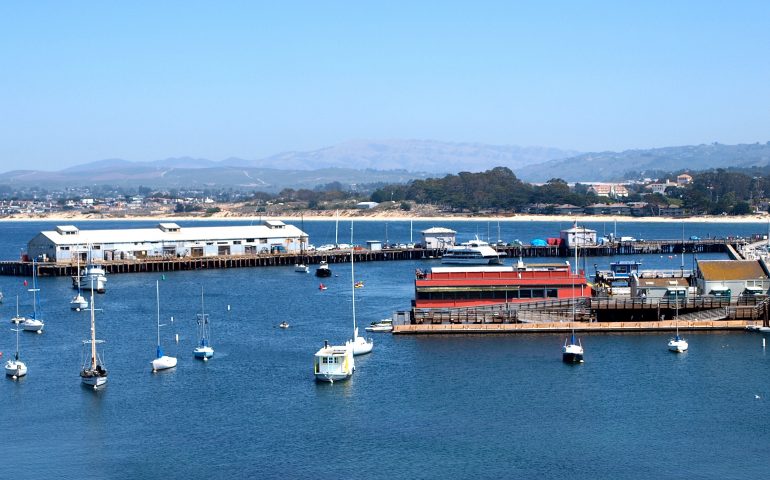
How do i get information about fish comming in at wharf 2. Because i live far away from Monterey but i like to fish for Markerel, sardines, anchovies… so any suggestion to get info about fishing!!
Interesting. I hope they tasted good.